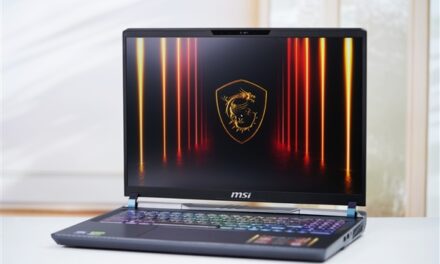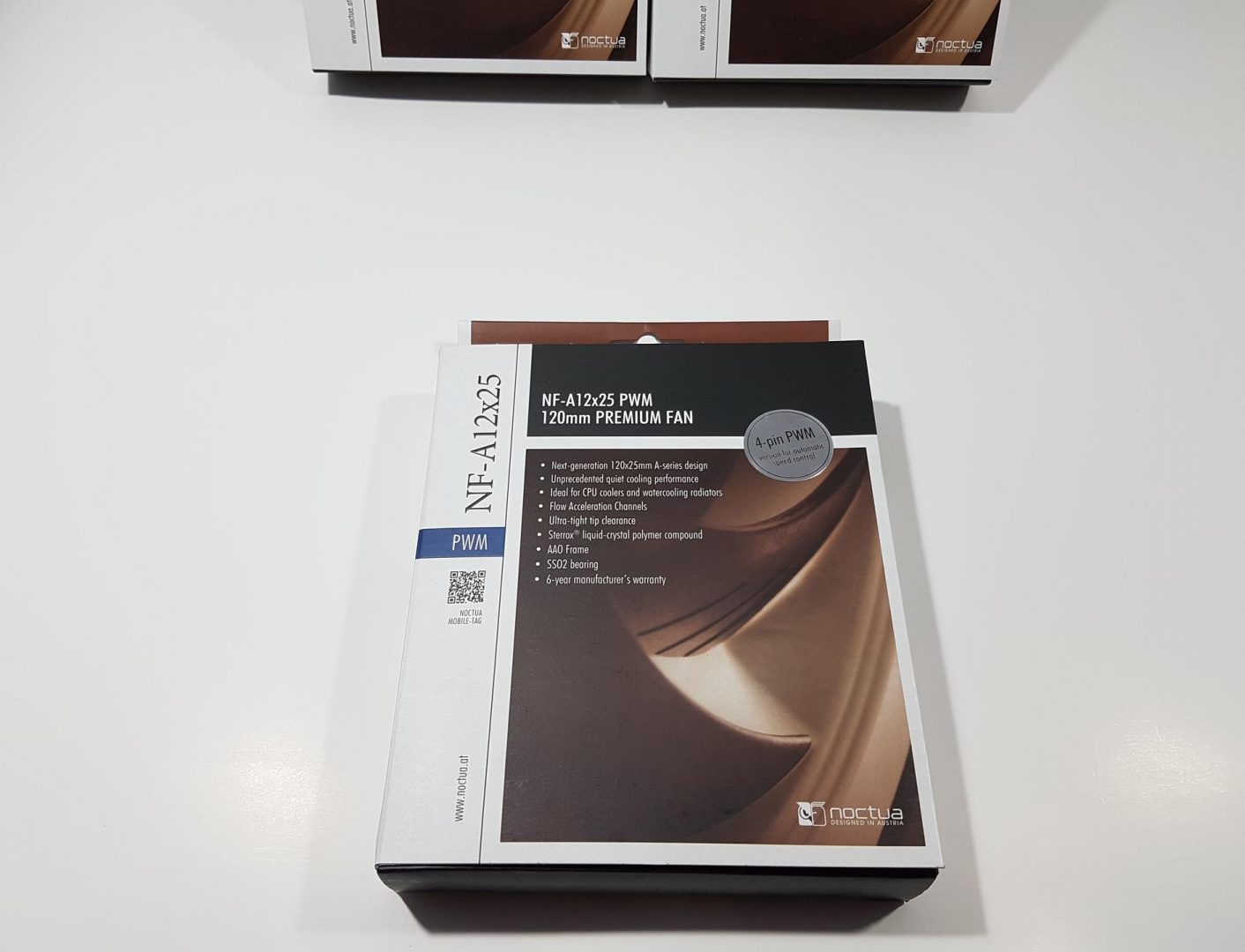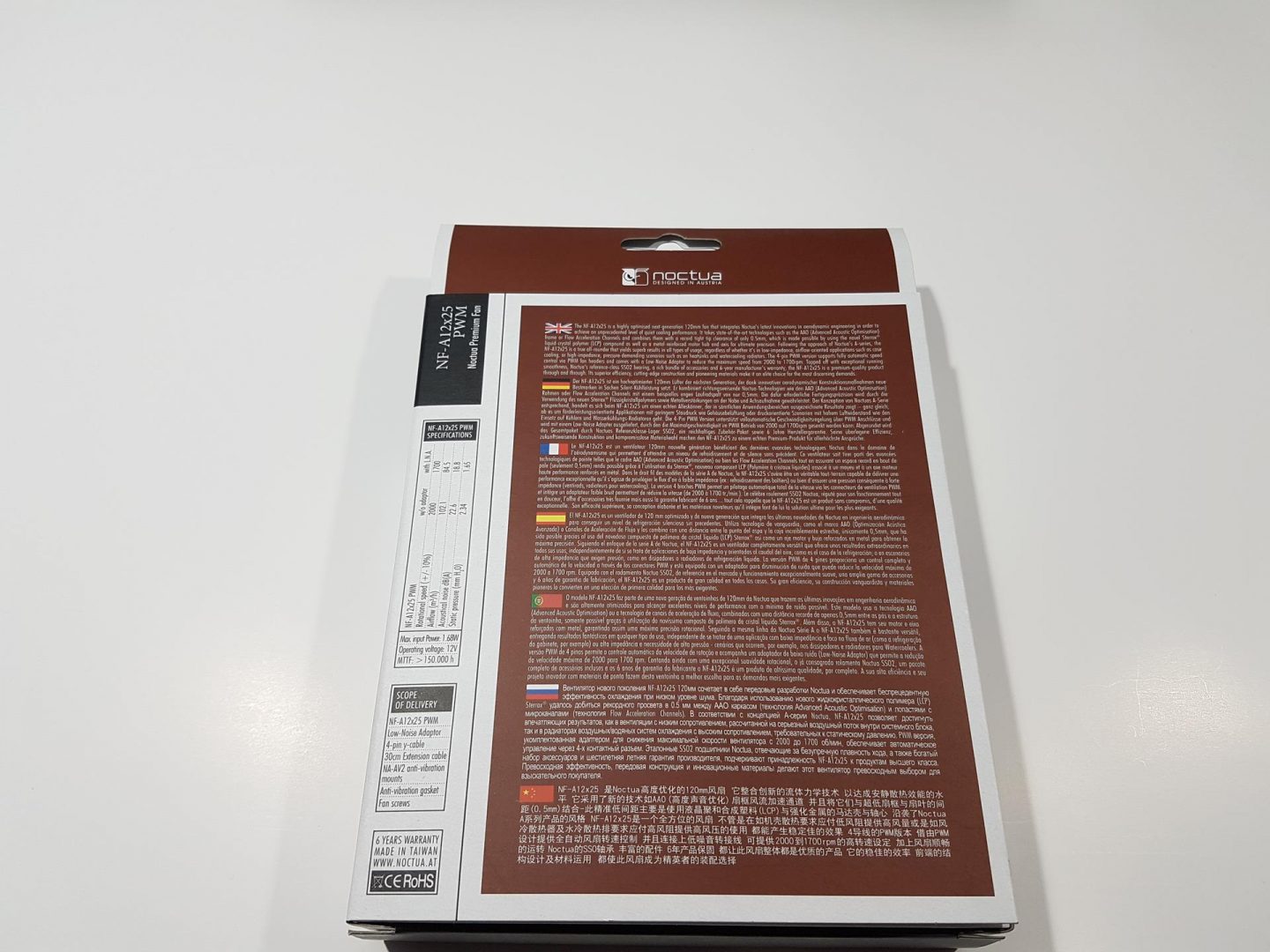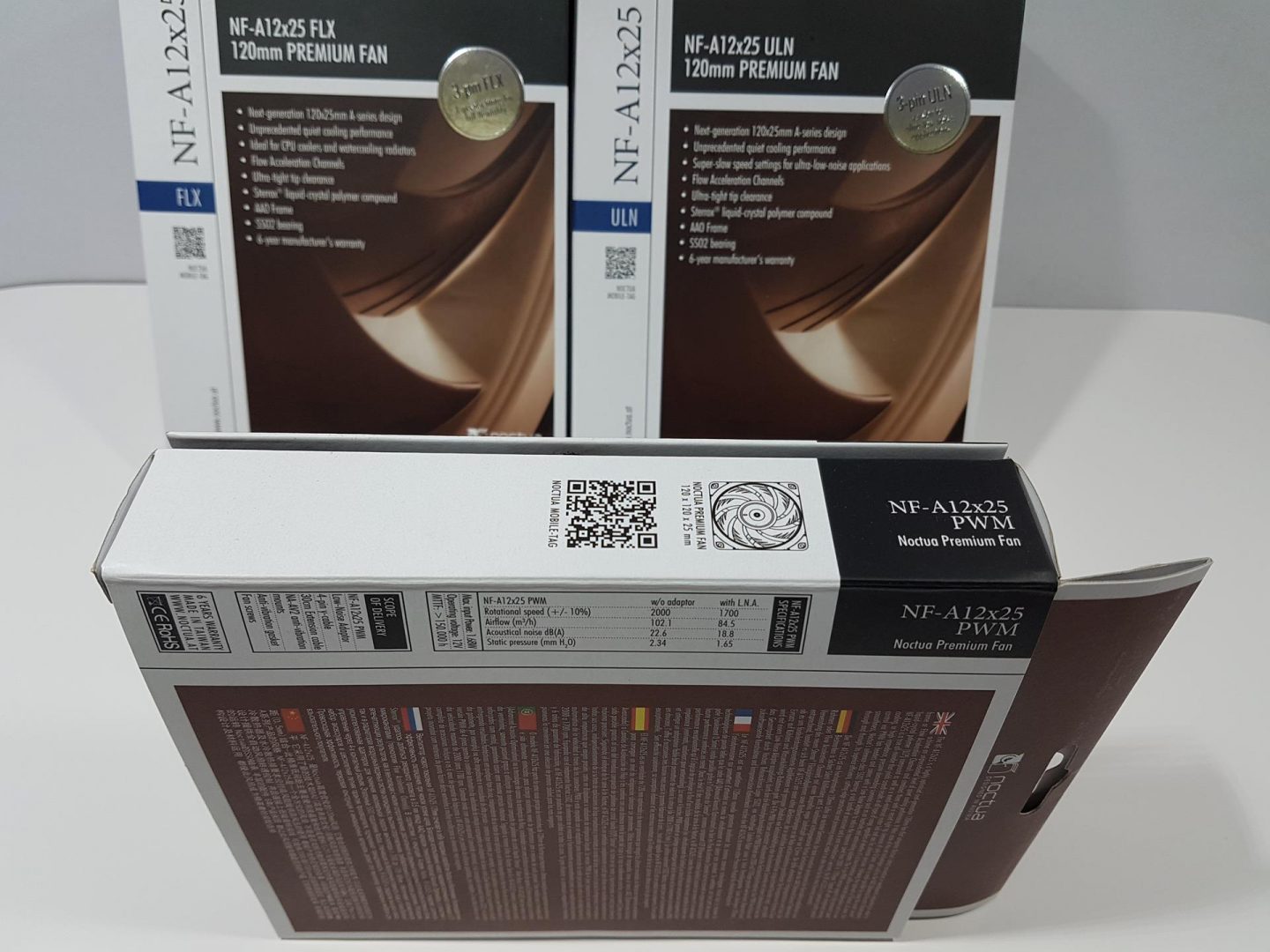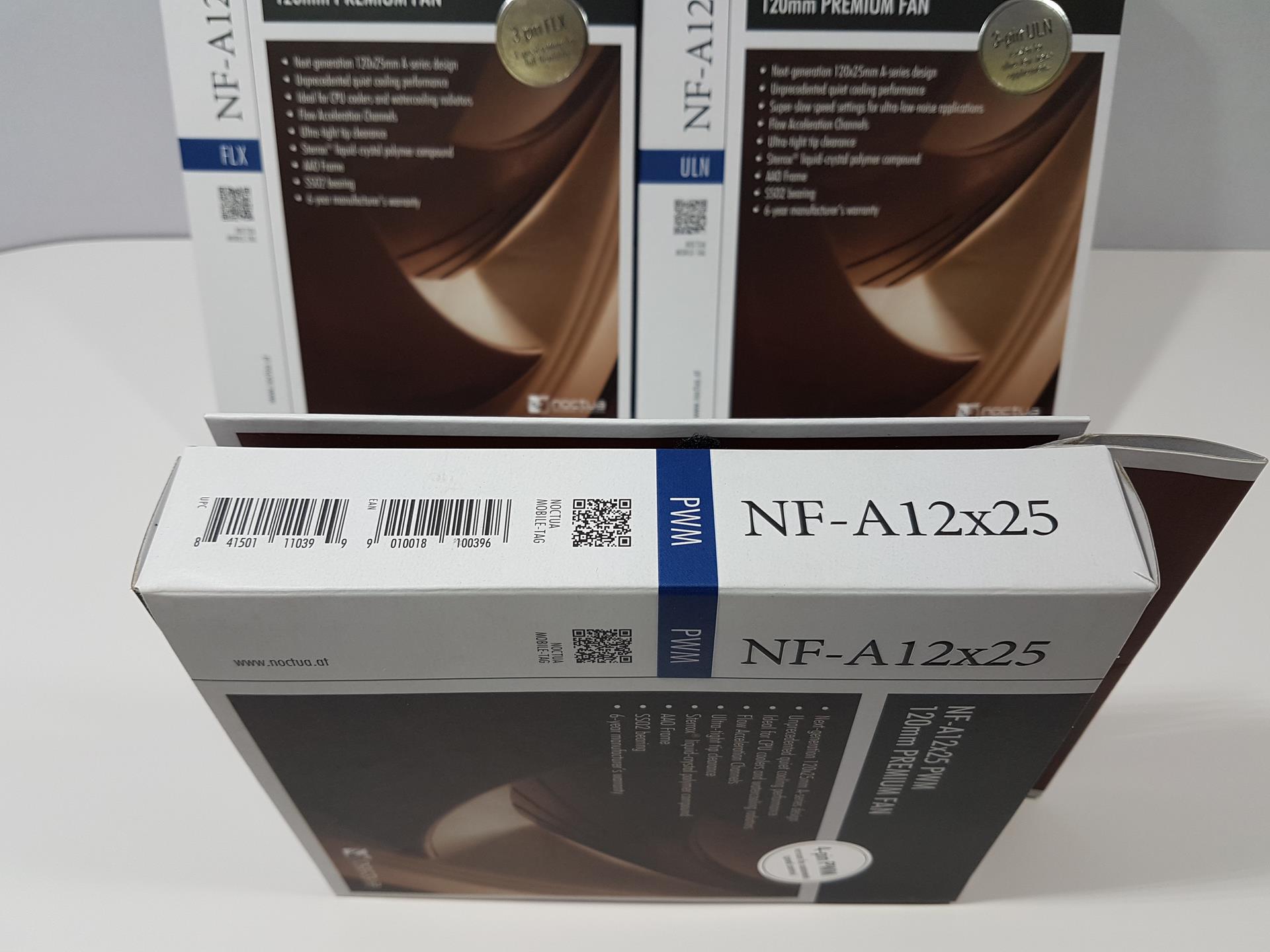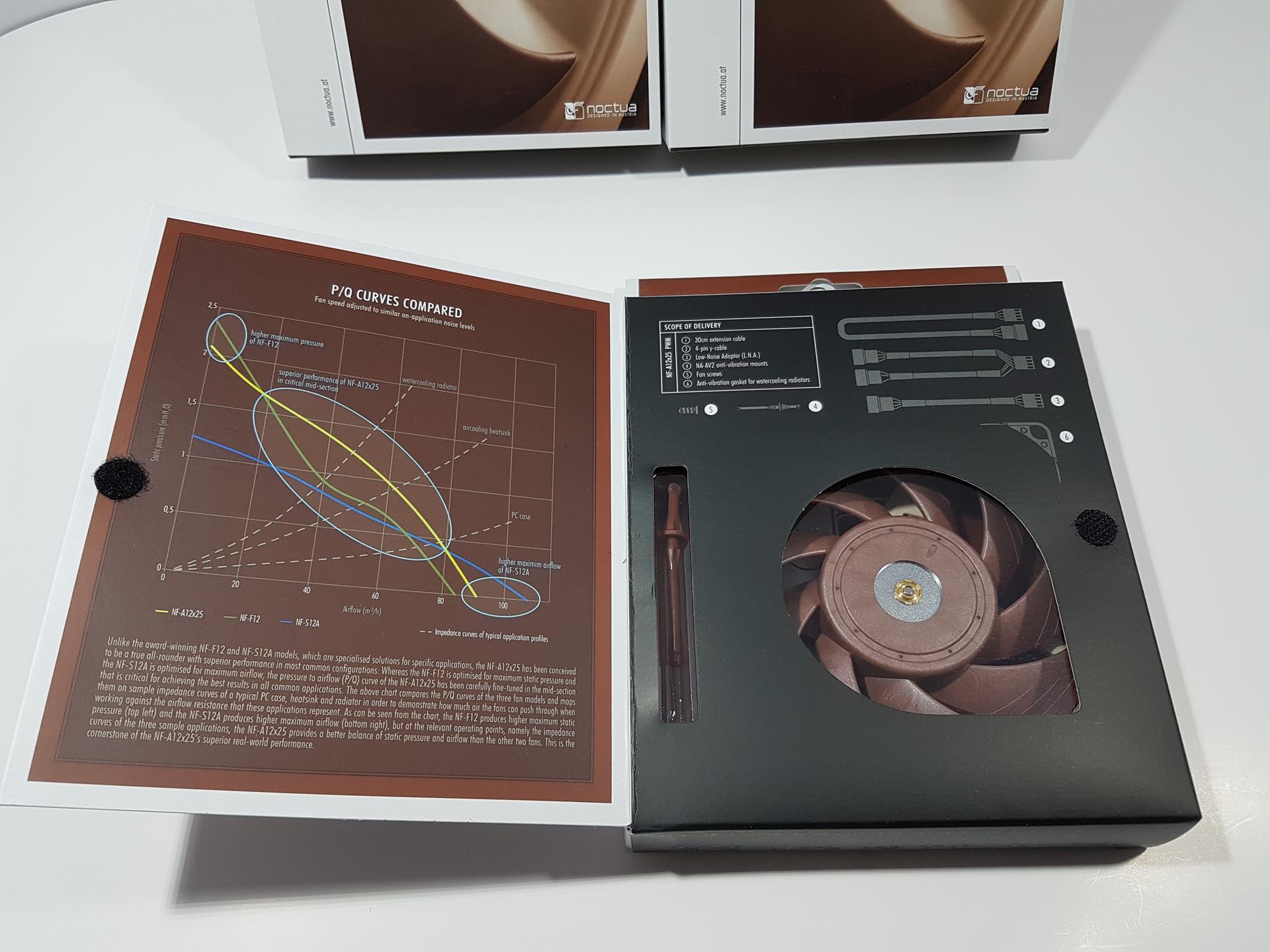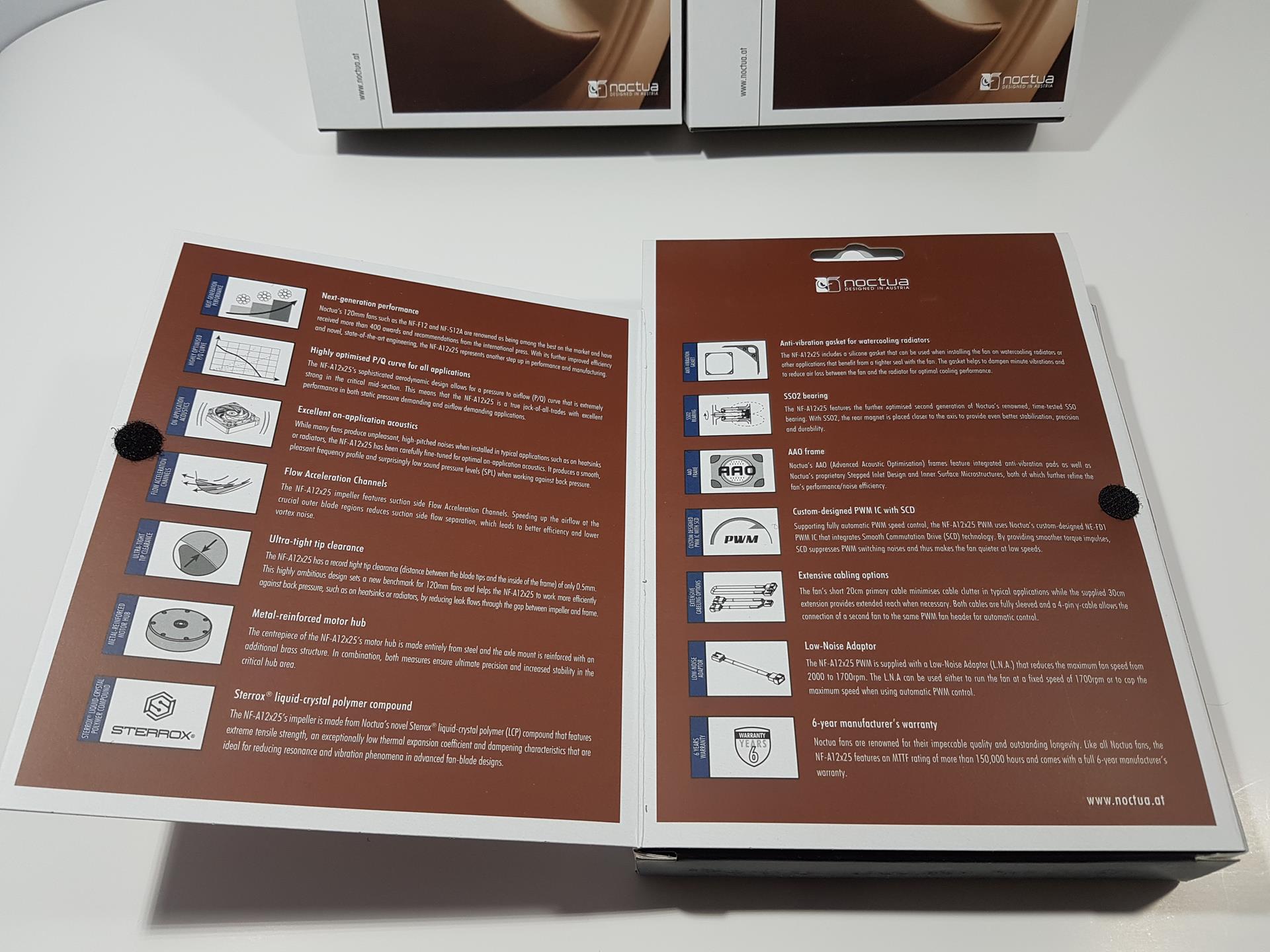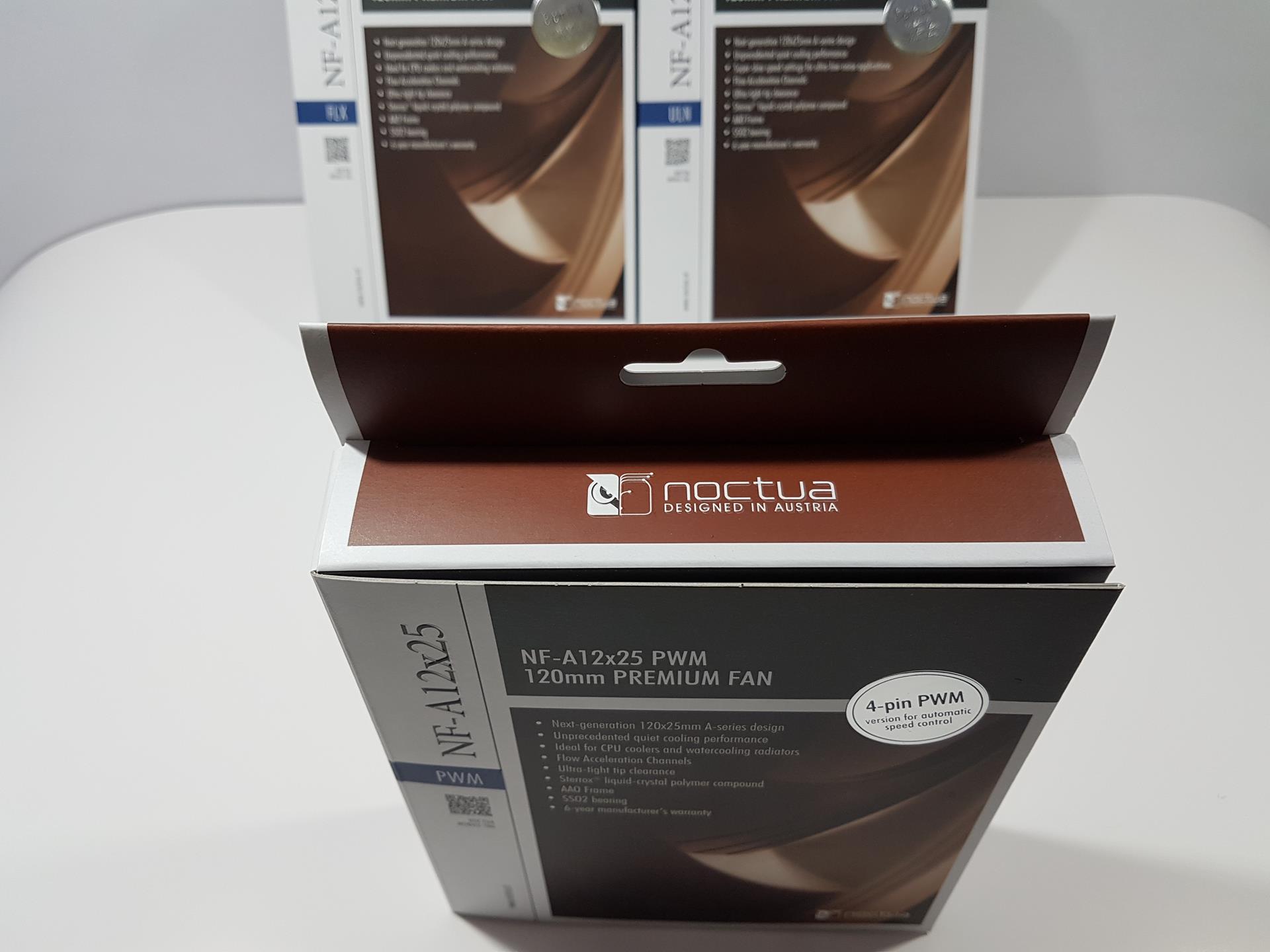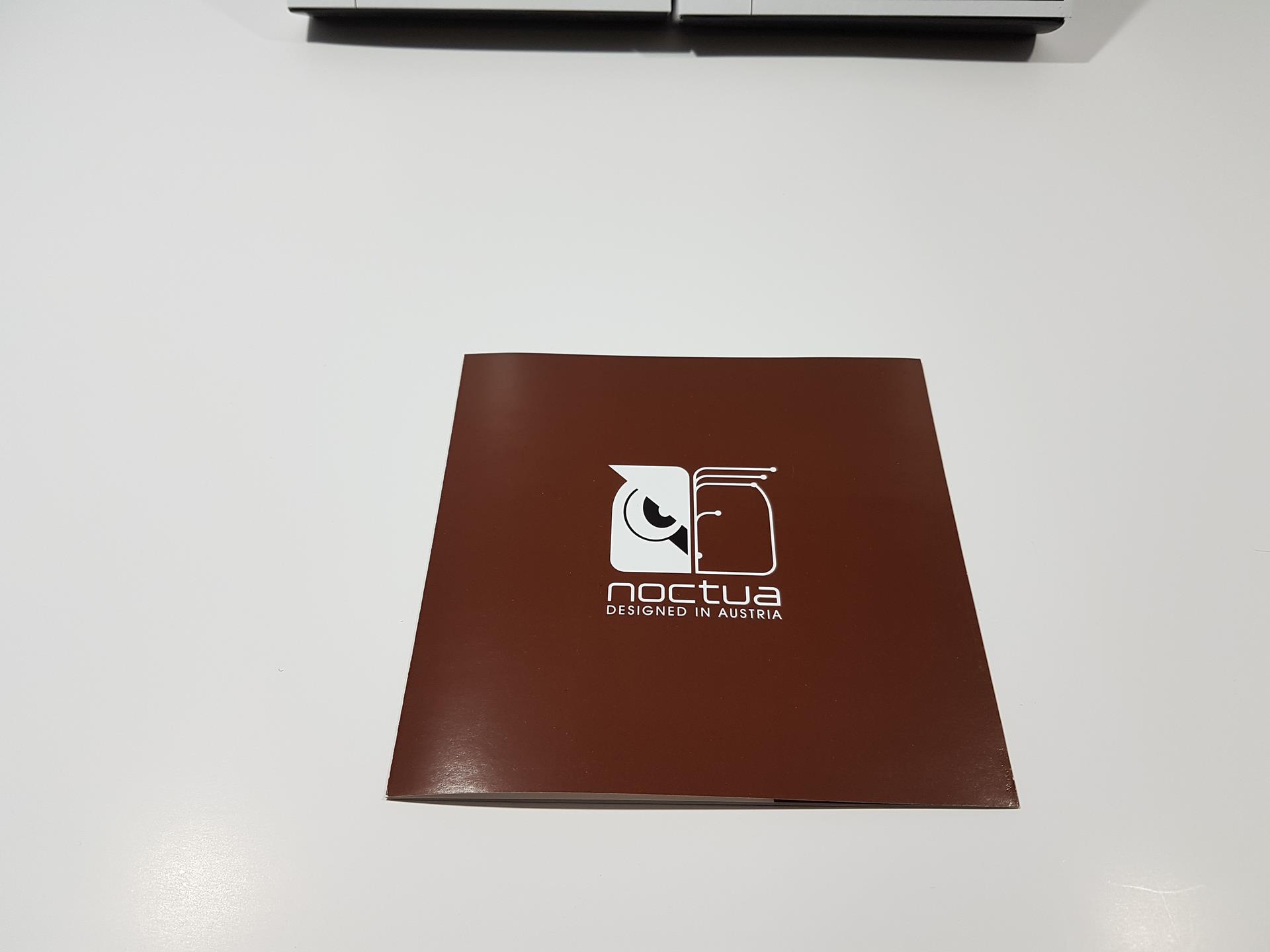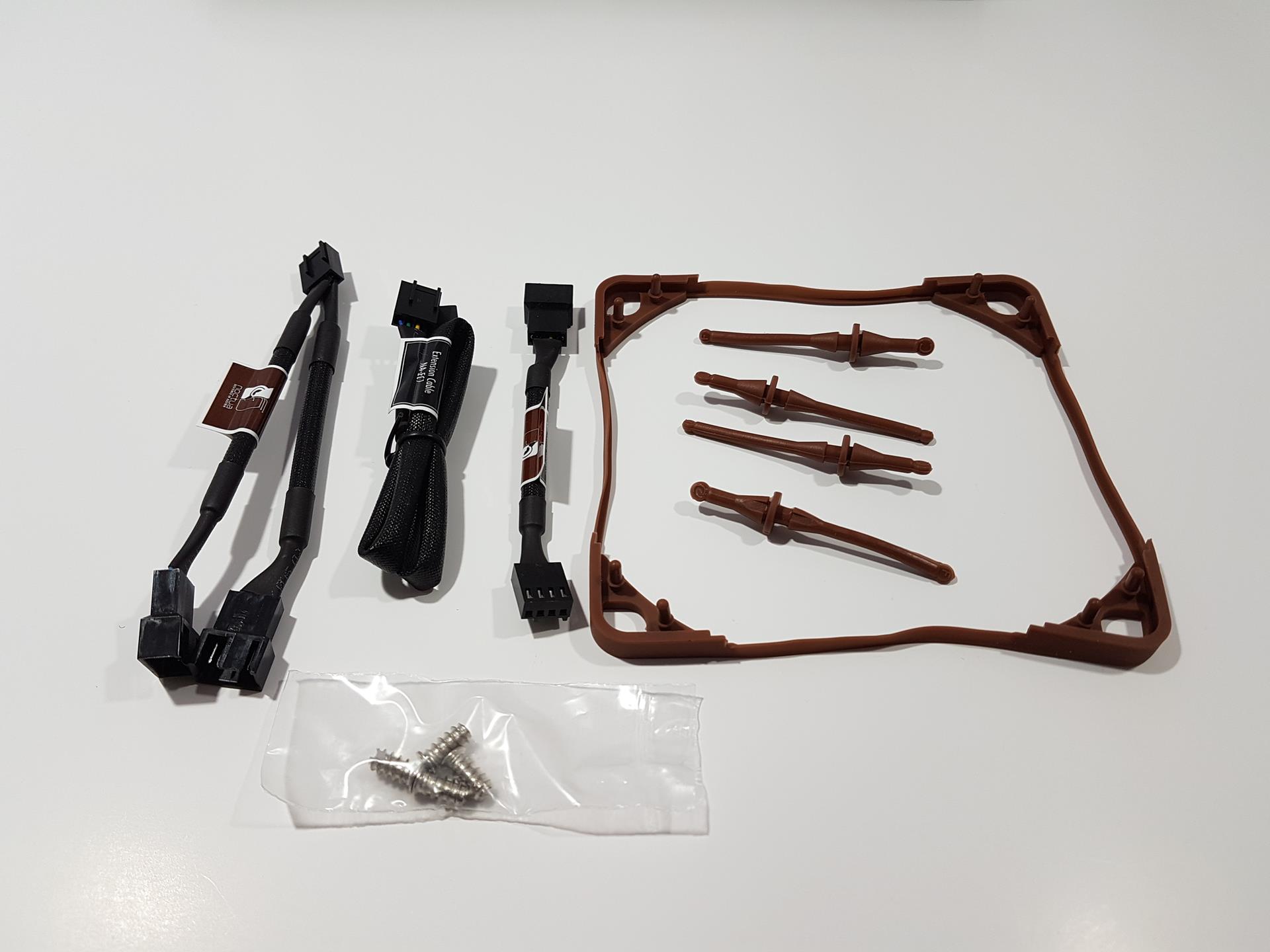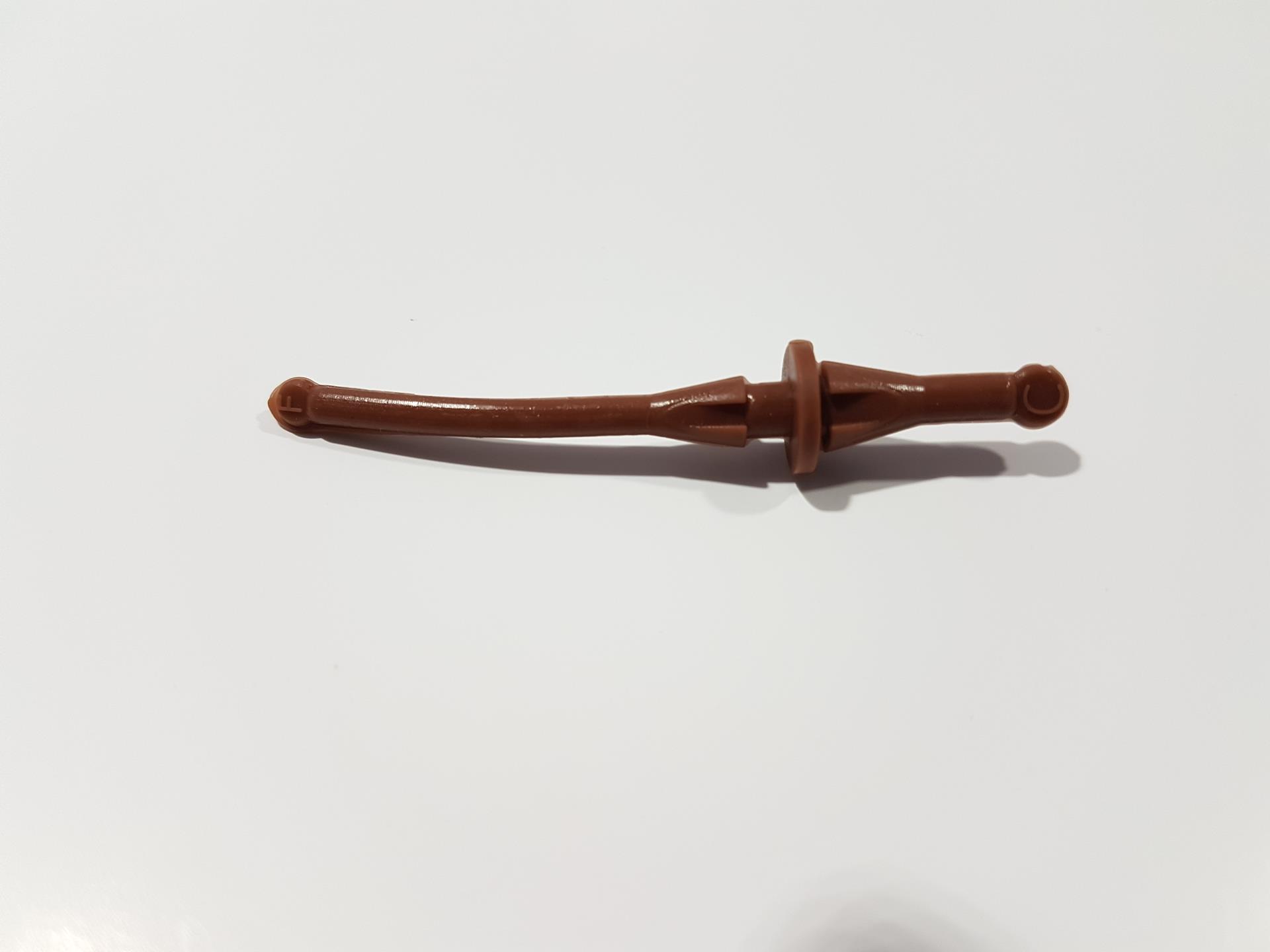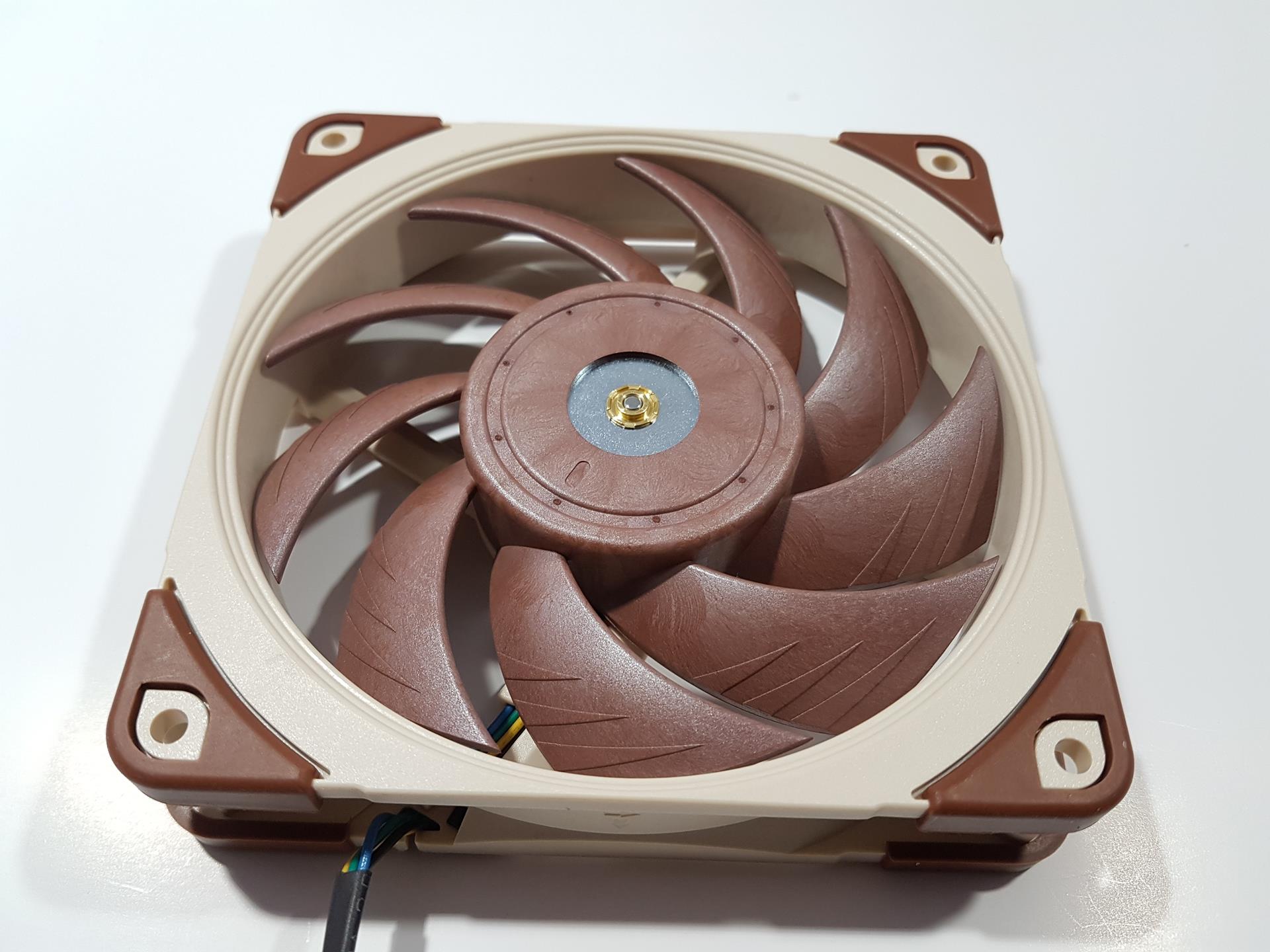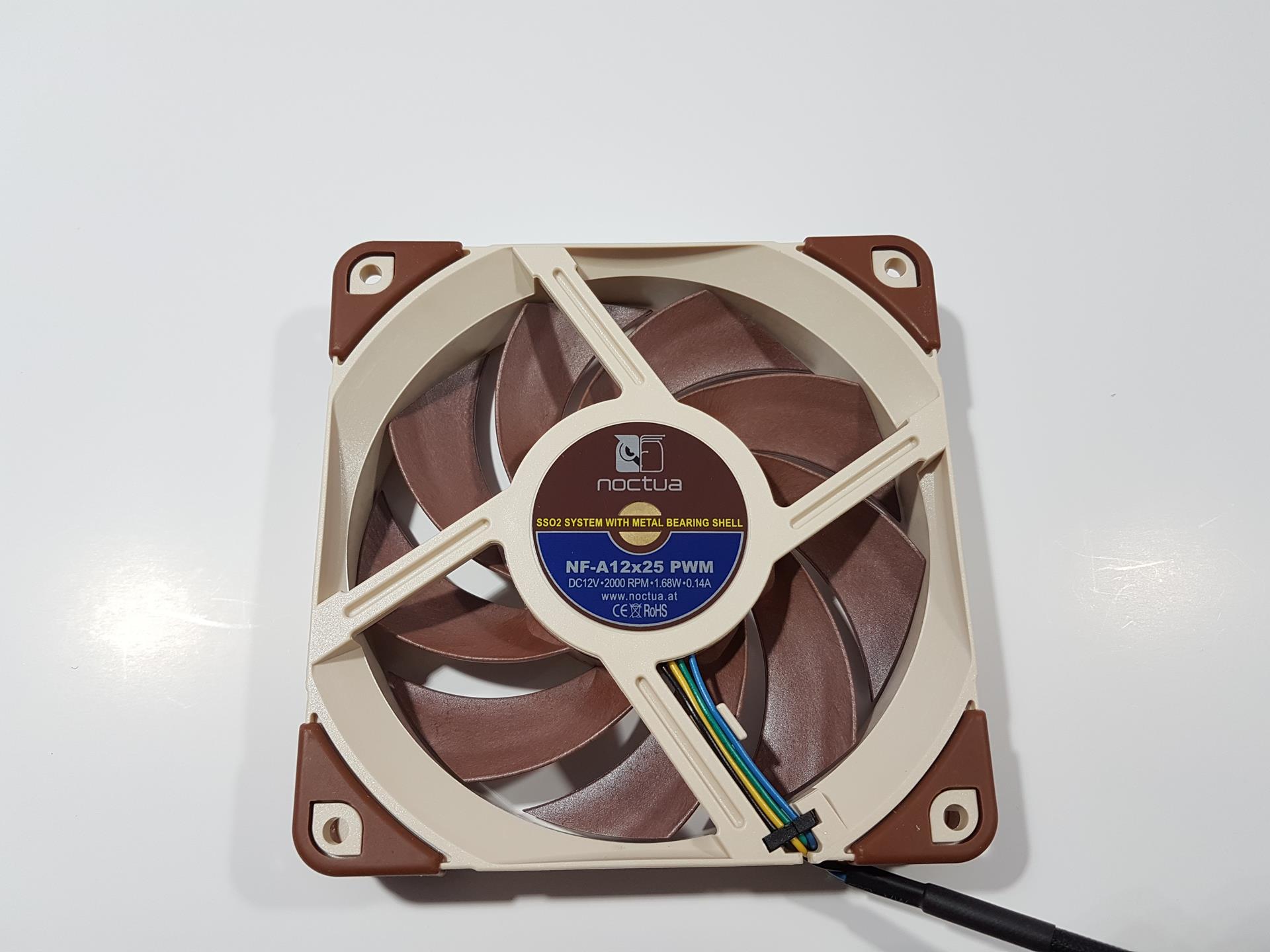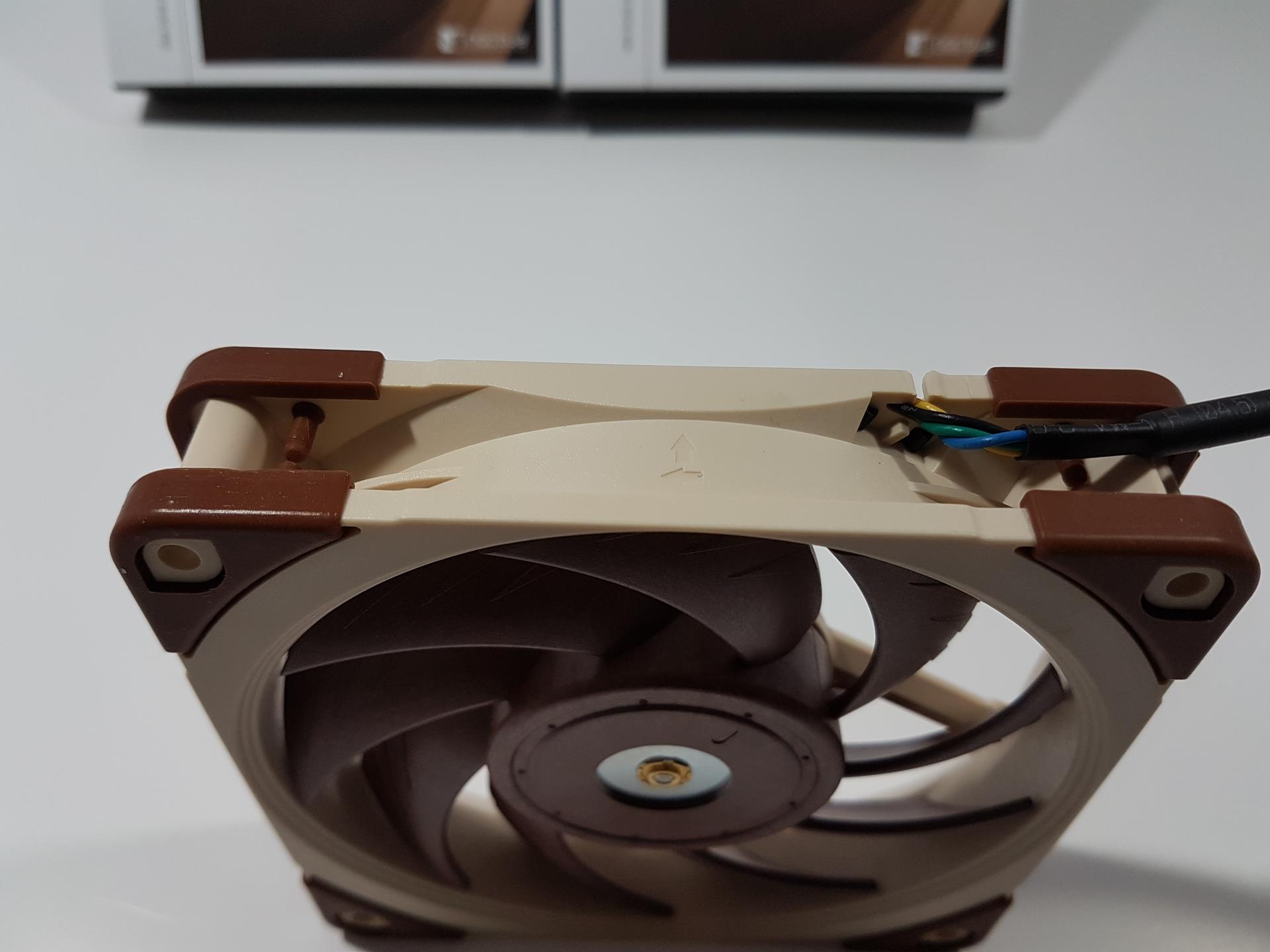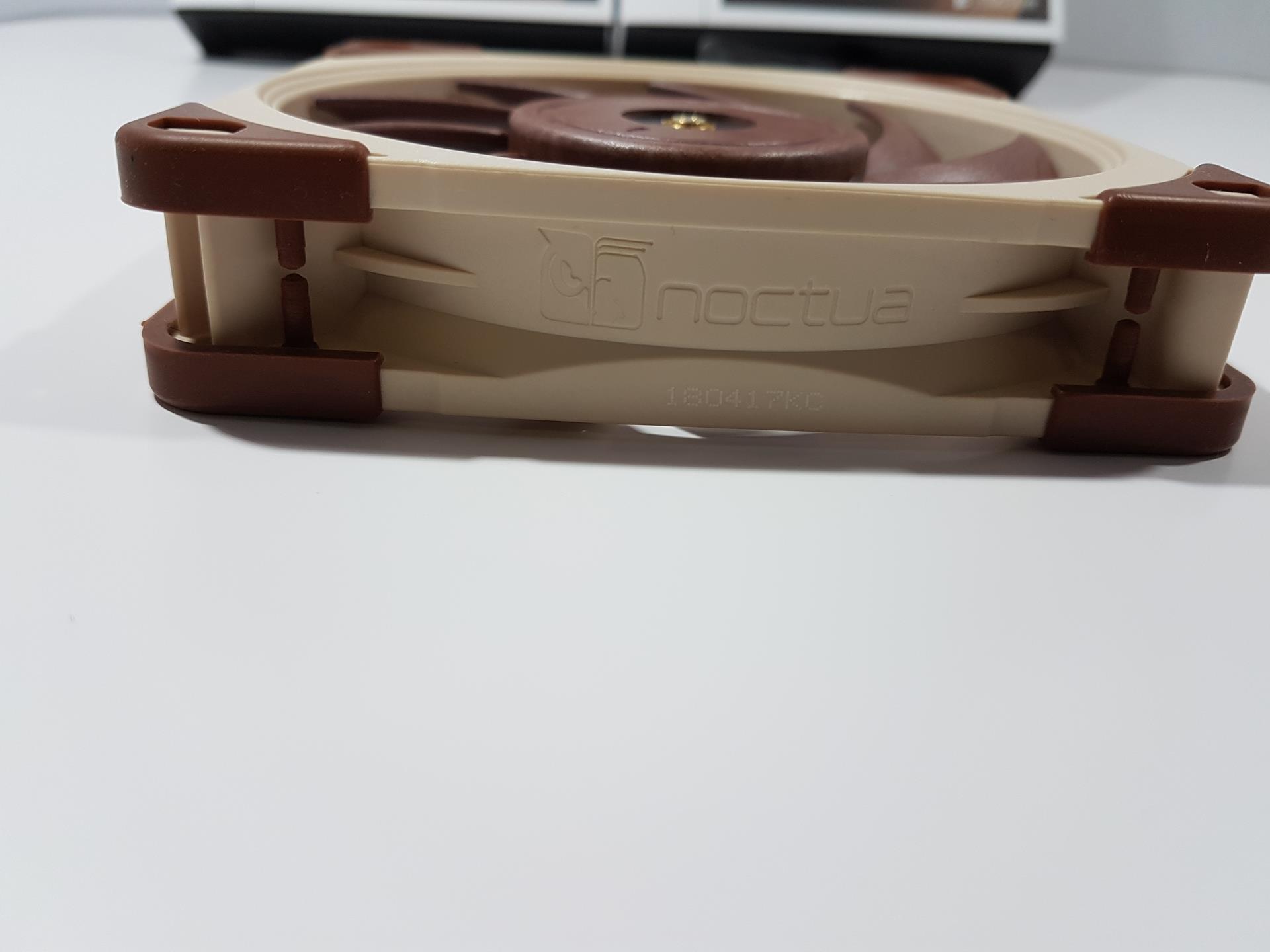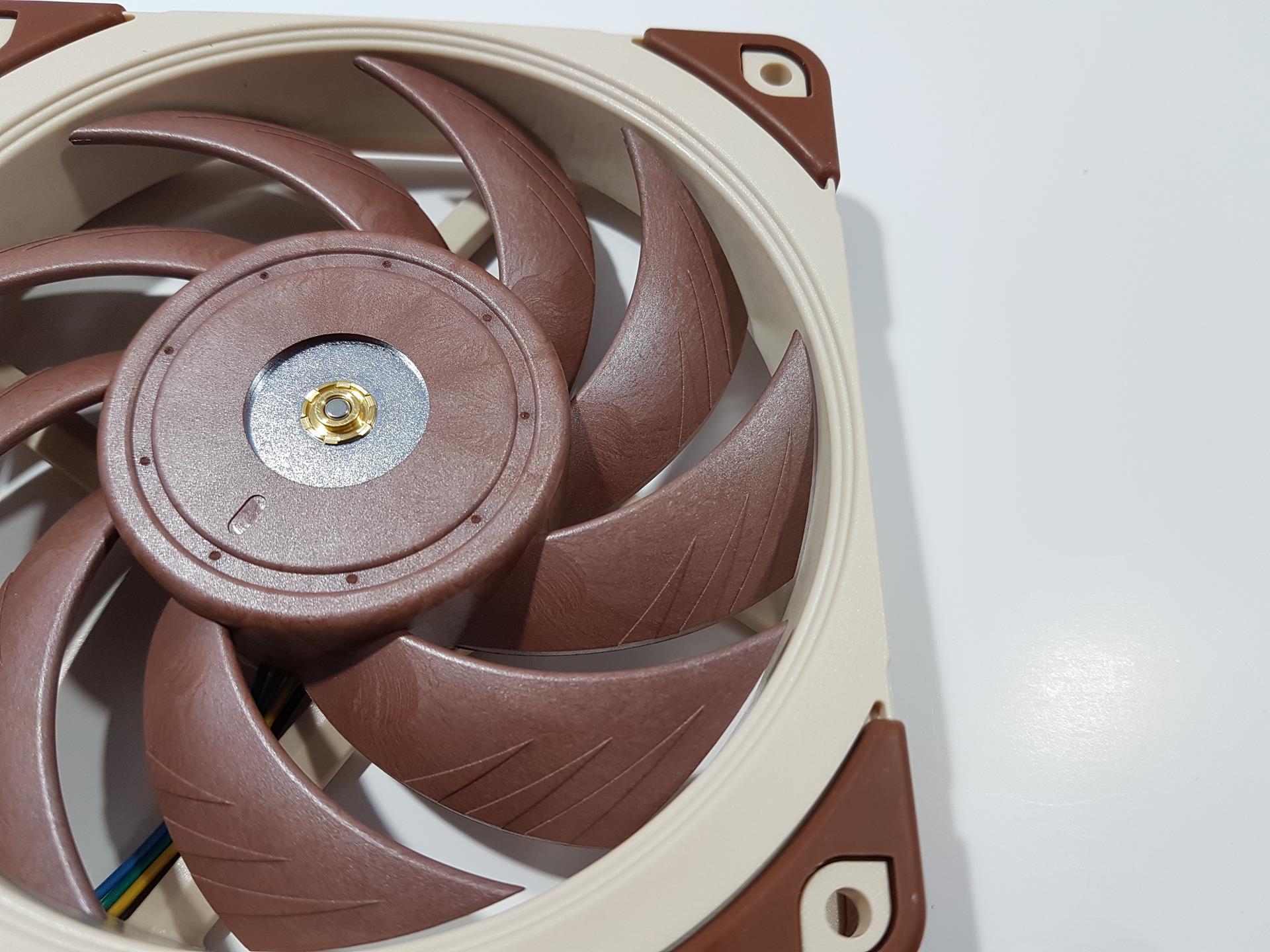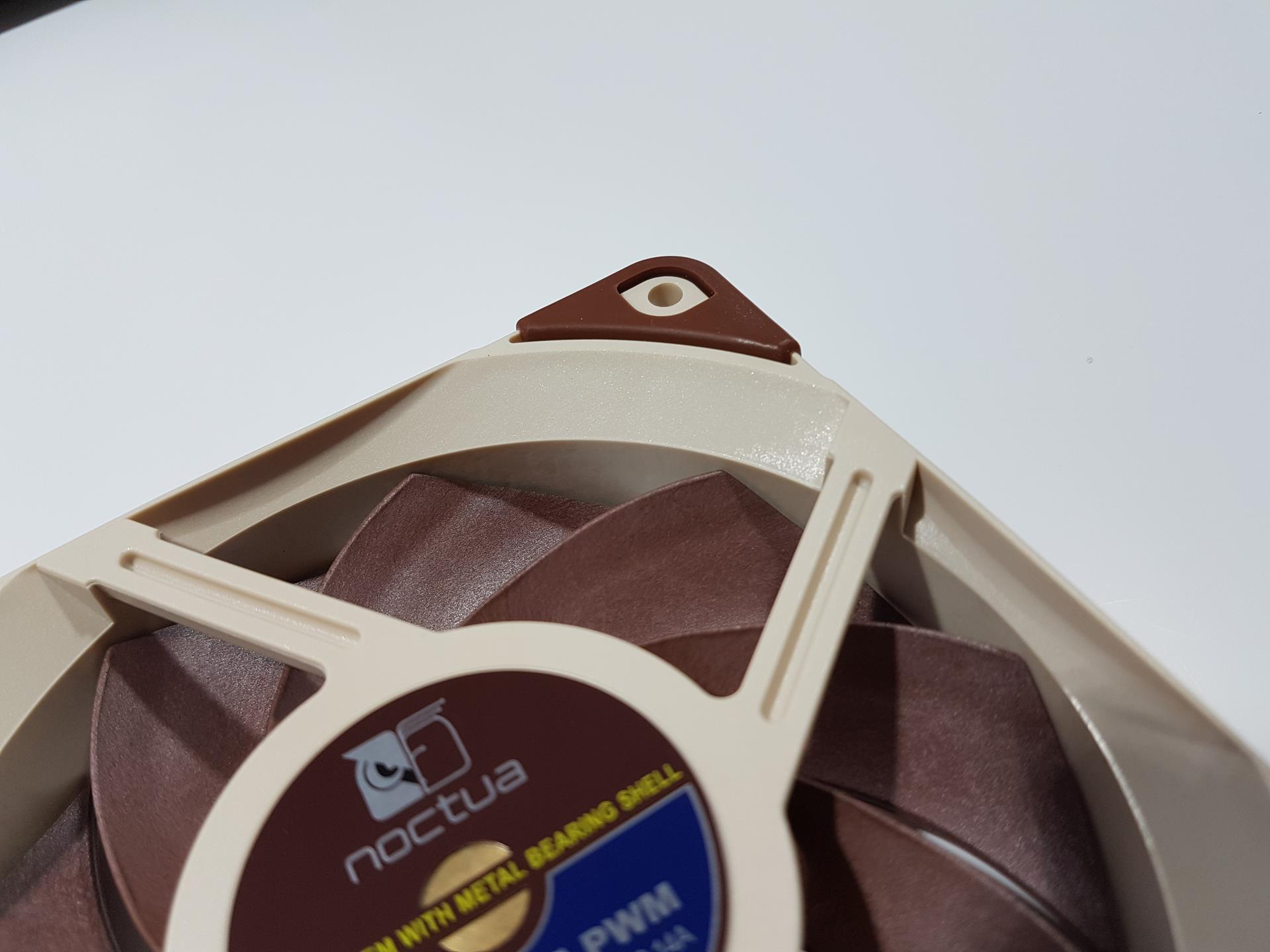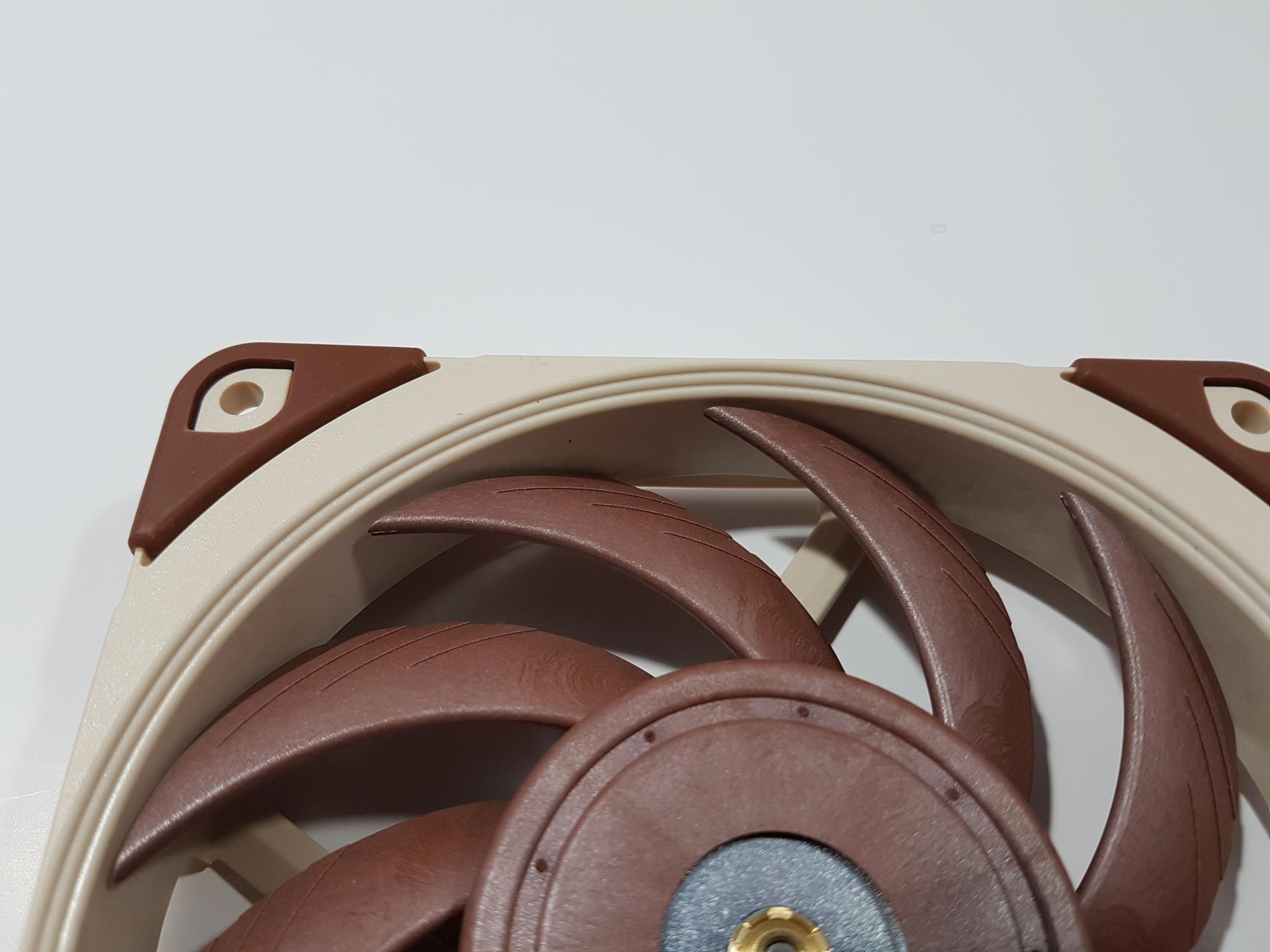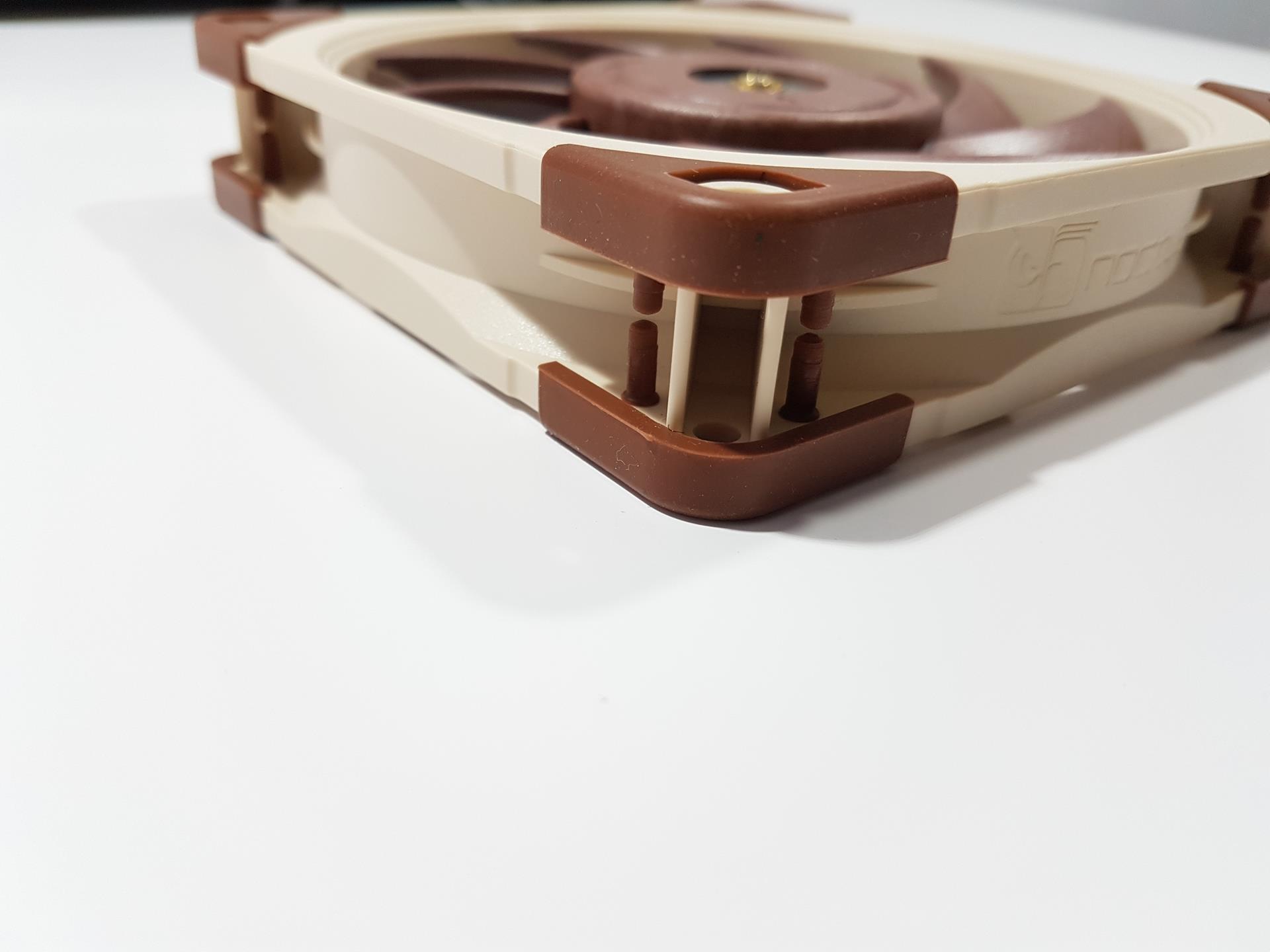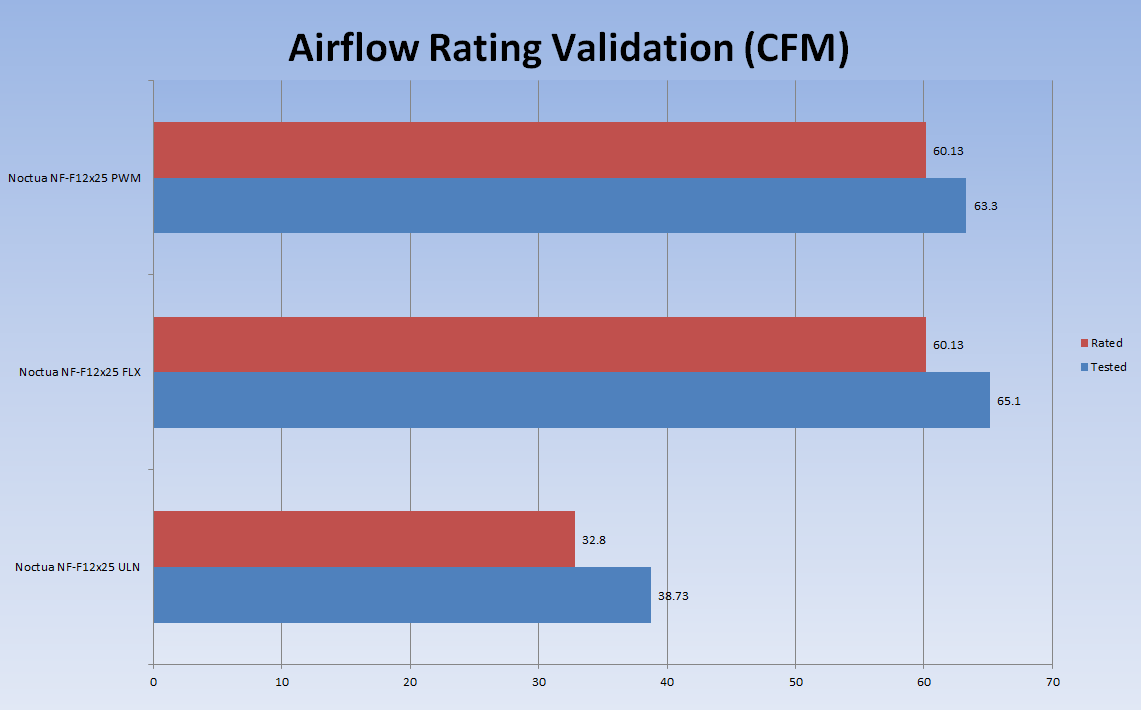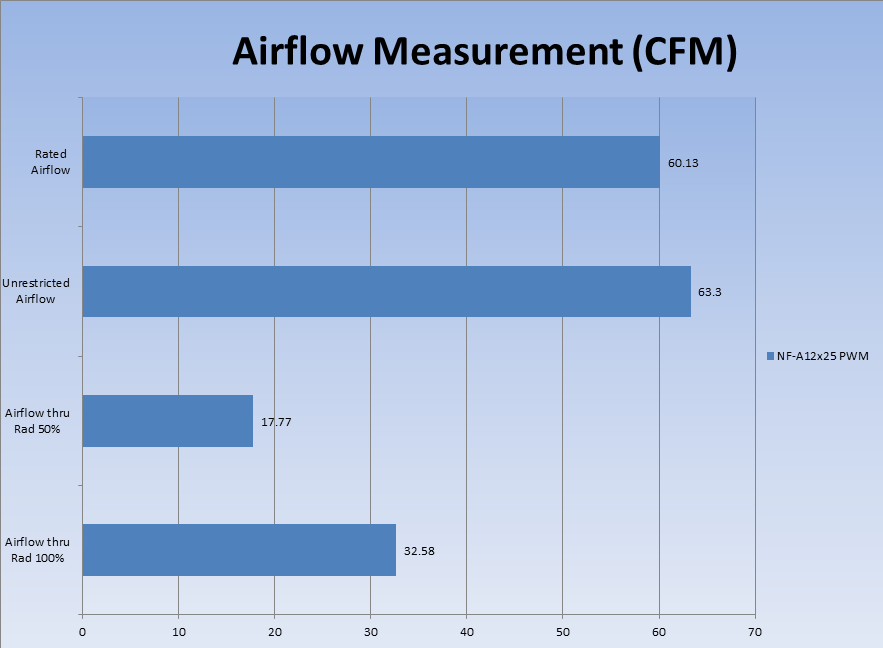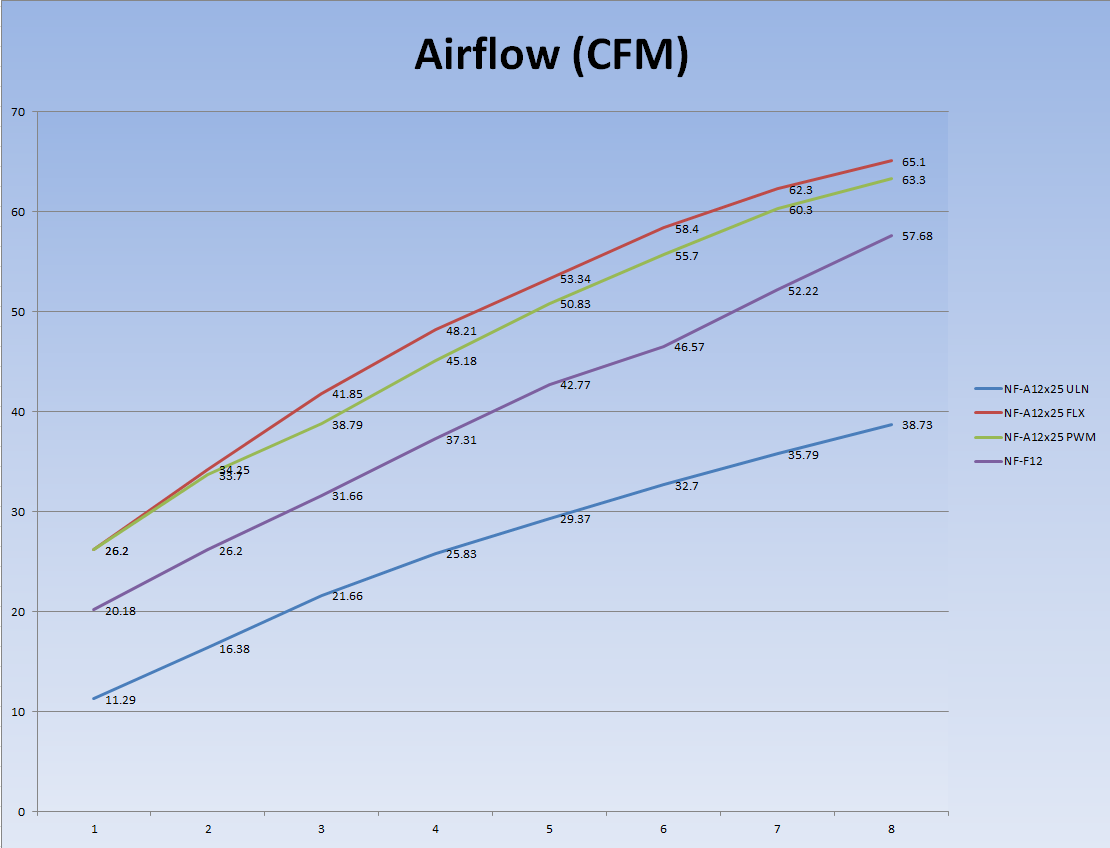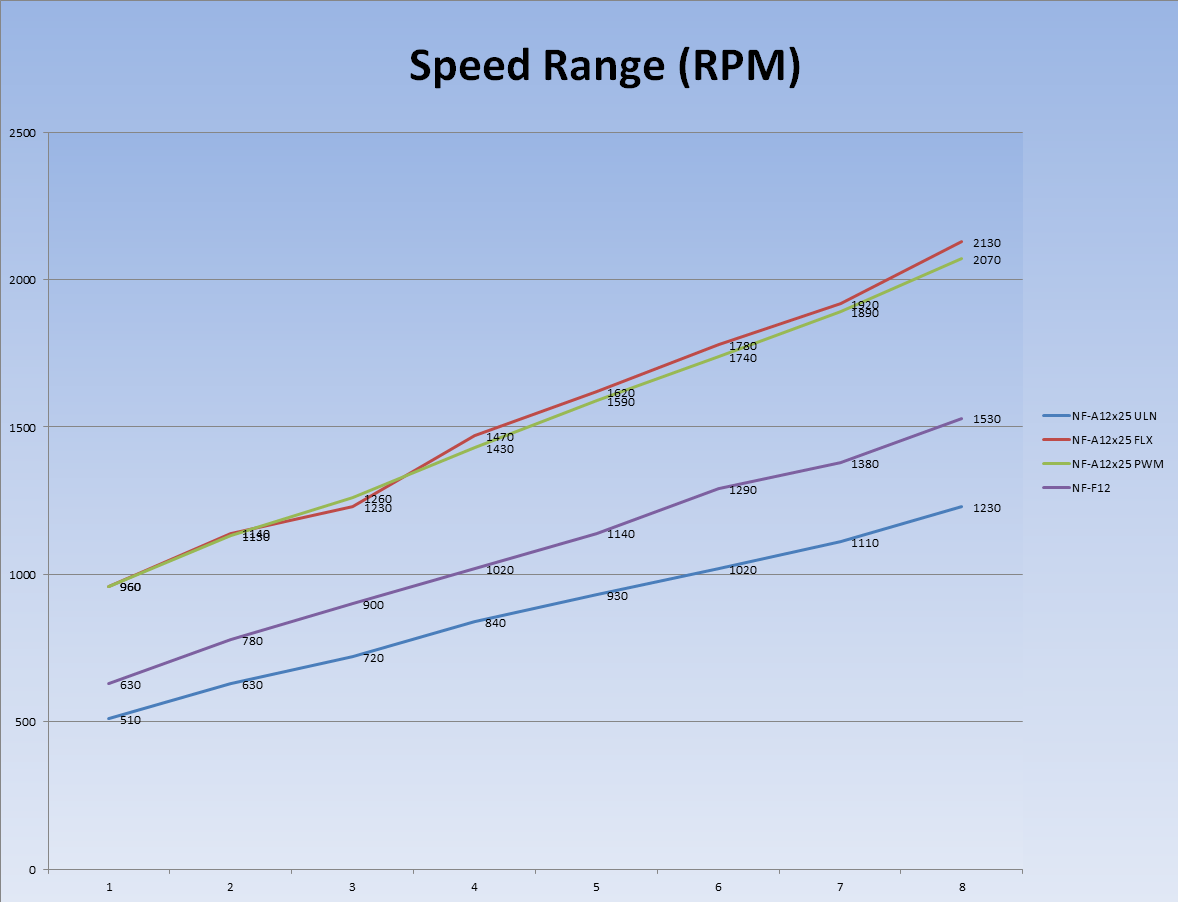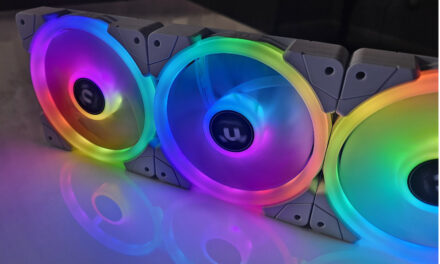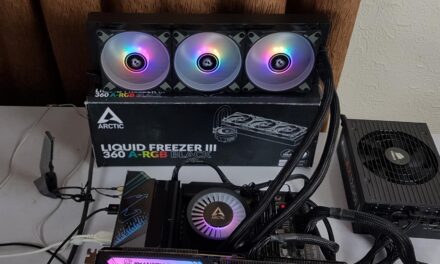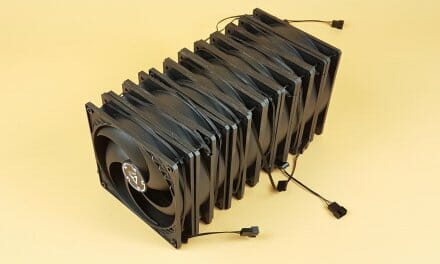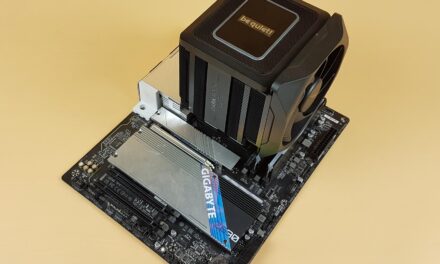
Noctua NF-A12x25 PWM, FLX, ULN versions Review and Performance Comparison
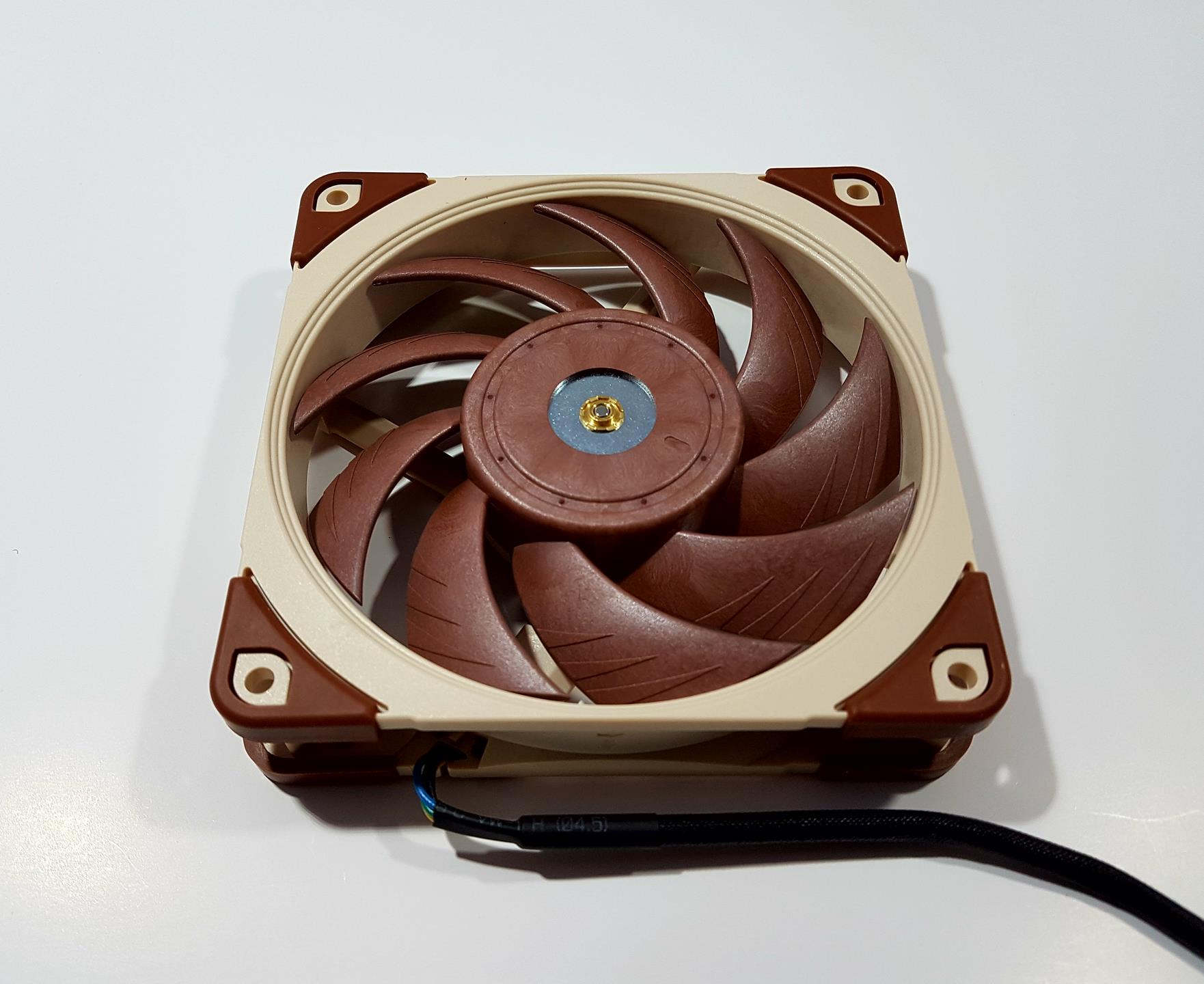
Introduction
Noctua originates from a collaboration between the Austrian Rascom Computer distribution Ges.m.b.H. and the Taiwanese cooling specialist Kolink International Corporation, pooling more than thirty years of experience in the development, manufacturing, and marketing of high-end cooling components. Established in 2005, Noctua took international silent enthusiasts’ hearts by storm and quickly developed into one of the most acclaimed suppliers of premium quality quiet cooling products. Today, Noctua is present in more than 30 countries across the globe and working with several hundred sales partners. Chosen by noise-conscious PC users, system integrators and industry clients alike, Noctua has become synonymous with impeccable quality, excellent customer service, and class-leading quiet cooling performance.
Finally, a time has come when we get to see the new generation of the fans from Noctua. Noctua has launched their NF-F12x25 premium fan superseding their legendary NF-F12 series of fans. This took them some 4.5 years and left us wondering what it is that Noctua is taking so much time for! Well, the answer is here in the form of new fans. Are they any good? Well, this is what we will be finding out in this content. Noctua has sent us their PWM, FLX and ULN versions of the NF-A12x25 fans. As per our request, we got to get 3x PWM versions for our standard testing on the 360mm CLC. This content is gonna be bit lengthy as we will be testing PWM versions on the Alphacool Eisbaer 360 as a part of our standard fan testing procedure. Not only that but we will also be testing all three versions of the Noctua NH-U12S for performance comparison with the NF-F12. In case you are wondering why I have not yet described anything about the fans themselves, I am saving it for the closer look section. Let’s start!
Item: NF-A12x25 PWM
Manufacturer: Noctua
Price: $29.90 for above versions at the time of the review
Specifications
Packaging and Contents
All versions of the NF-A12x25 come in a same packaging and styling with similar contents. We will be showing the unboxing of the NF-A12x25 PWM version here. The fans come in a cardboard box packaging in typical Noctua branding. The box itself will give you a premium feel to it. The front cover has a fan’s model printed on the top side left side. There is a silver color sticker pasted on the top right side stating 4-pin PWM version for automatic speed control. For ULN, it is 3-pin ULN version for ultra-low noise applications and for FLX it is 3-pin FLX version with three speed settings. Salient features of the fans are printed on the main section. Noctua brand name and logo are printed on the bottom right side. The backside of the box has features highlight of the fans printed in 7 different languages. Major specs of the fan are printed on the left side below the model no of the fan. The fan carries 6 years of Noctua legendary warranty showing the confidence of the maker in their products. The left side of the box has a model of the fan printed on the top. PWM signifies that it is 4-pin PWM version. The EAN and UPC info labels are printed at the bottom. The top side of the box is the one where the box is opened to take the contents out. It is in dark brown color with Noctua brand name and logo printed in the middle. The fans are designed in Austria. The right side has a model of the fan printed over the black color background. There is a diagram of the fan with the dimensions. Opening the back flapper cover will show the salient features of the fan and the underlying technology. We will take a look at them later one. Opening the front flapper cover will show the P and Q graph comparing the NF-F12 and NF-S12A fans with the NF-A12x25 fans. On the right side, we get to see the glimpse of the fan itself from its middle and a NA-AV2 anti-vibration mount. Contents of the box are presented on the top side. I love the presentation of the product and Noctua gets 10/10 from me in this regard. Open the box from top side. Take out the transparent container from the box. There is a user guide as well placed underneath the container. The container is a two-fold design with top cover resting on the bottom one securing the contents in a pleasant presentable manner.
Contents
Noctua has included a plethora of the accessories in each fan. Noctua has raised the bars on the accessories definitely giving the users a peace of mind with everything that one could need but this has come at a higher price. These include:
- 300mm Extension Cable
- 4-pin y-cable [PWM version only]
- 3:4 pin adapter [FLX and ULN versions only]
- Low Noise Adapter (L.N.A) [PWM and FLX versions only]
- Ultra Low Noise Adapter (U.L.N.A) [FLX and ULN versions only]
- 4x NA-AV2 mounts
- 4x Silver Fan Screws
- Anti-Vibration gasket for water cooling radiators.
Closer Look
The new NF-A12x25 series of the fans is a new generation from Noctua taking over the legendary NF-F12 and NF-S12A fans. Now, this may surprise many as we know that Noctua has always kept their fans lineup separate from high static pressure and high airflow requirements with a line up coming in the middle of both. This time around Noctua has gone leaps and bounds for bringing in a single package that would suffice for both sorts of requirements. No longer would you need to concern about checking the static pressure ratings and airflow ratings before deciding upon the fans. The NF-A12x25 comes with the theme of single fan catering for all these needs. Here is what Noctua has to say about the PWM version of the fan, “The NF-A12x25 is a highly optimized next-generation 120mm fan that integrates Noctua’s latest innovations in aerodynamic engineering in order to achieve an unprecedented level of quiet cooling performance. It takes state-of-the-art technologies such as the AAO (Advanced Acoustic Optimisation) frame or Flow Acceleration Channels and combines them with a record tight tip clearance of only 0.5mm, which is made possible by using the novel Sterrox® liquid-crystal polymer (LCP) compound as well as a metal-reinforced motor hub and axis for ultimate precision. Following the approach of Noctua’s A-series, the NF-A12x25 is a true all-rounder that yields superb results in all types of usage, regardless of whether it’s in low-impedance, airflow-oriented applications such as case cooling, or high-impedance, pressure-demanding scenarios such as on heatsinks and water-cooling radiators. The 4-pin PWM version supports fully automatic speed control via PWM fan headers and comes with a Low-Noise-Adaptor to reduce the maximum speed from 2000 to 1700rpm. Topped off with exceptional running smoothness, Noctua’s reference-class SSO2 bearing, a rich bundle of accessories and 6-year manufacturer’s warranty, the NF-A12x25 is a premium-quality product through and through. Its superior efficiency, cutting-edge construction and pioneering materials make it an elite choice for the most discerning demands.”
Let’s take a closer look at the fans and discuss what goes into making them and standing them out of the competition. The fans are still in the Noctua’s typical brown and beige colors combination. I would love Noctua to release their Chromax versions down the road though keeping the price of that would be a concern. The front side of the fan has same anti-vibration dark brown color pads on the mounting holes. These are removable. Unlike the fan blade design as we saw on the NF-F12, there are 9 blades with textured surface in the dark brown color. Each blade has raised surfaces towards the trailing edge. These are forming the air channels on the blades which Noctua refers to as Flow Acceleration Channels. By speeding up the airflow at the crucial outer blade regions, this measure reduces suction side flow separation and thus leads to better efficiency and lower vortex noise. The motor hub has a diameter of 50mm which is quite large as compared to the standard axial fans. Fan blades are also less wide as compared to the blade design optimized for the high static pressure. This motor hub is metal reinforced which has added more to the weight of the fan but it has a crucial function in the overall design of the fan. The centerpiece of the NF-A12x25’s motor hub is made entirely from steel and the axle mount is reinforced with an additional brass structure. In combination, both measures ensure ultimate precision and increased stability in the critical hub area. The very reason why there is a metal construction and brass reinforcement is that Noctua has been researching on how to reduce/eliminate the impeller creep. The impeller creep is a phenomenon in which over extended periods of use and thermal cycling, axial fan impellers undergo minute creep deformations due to the centrifugal forces pulling the mass outwards, which result in minute increases of the fan’s diameter. This has much to do with the type of material used to form the impellers. Typical fan’s impellers are made of PBT which can extend to 0.2mm in the longer run. In order to cater for this, there is a gap between the frame and impeller. But having this much of gap would present the air turbulence on the edges of the impellers and would contribute more towards the noise. Noctua has been researching on the material which can be used to form the impeller in such a manner that it would reduce/eliminate the creep and thus would enable them to reduce the gap between the fan’s frame and impellers. They have developed Sterrox which is a novel liquid-crystal polymer (LCP) type material that has much better dimensional stability and less creep as compared to conventional engineering thermoplastics such as ABS, PA, PBT or PC. The name Sterrox® is derived from the Greek word στερρός, which means stiff, firm, solid, hard or rugged. This also answers the textures that we can see on the impellers. Sterrox® is Noctua’s own customized type of fibre-glass reinforced LCP that has been specifically fine-tuned for use in next-generation fan designs such as the NF-A12x25. Its extreme tensile strength, exceptionally low thermal expansion coefficient, high environmental inertia and excellent dimensional stability have made it possible to reduce impeller creep phenomena to levels that were previously unthinkable with PBT- or PA-based impellers. Due to its chemical properties, the Sterrox has enabled the Noctua to reduce the surface vibrations on the impellers which enables them to reduce the vibration noise to a minimal level. This is like two-in-one flavor coming from the Sterrox. I would not be going into the details. You can read this all out on Noctua’s website as they provided a technological background. The Sterrox has enabled the Noctua to maintain the gap between the impeller and the frame to be 0.5mm which is huge milestone in the Fan’s technology as it will help fighting the back pressure from the resistant surface and air leaks. This design requirement poses another challenge for their design team that was to ensure the strength of the impellers and to hold the assembly in line as the frame is still in the plastic and a way out to remove the intolerances. To address these challenges, their design team has turned the motor hub around as it is made entirely of the steel to reinforce the outer frame which is still made of plastic. At the same time, the axle mount has been reinforced with an additional brass piece in order to stiffen the joint between axis and impeller. In combination, both measures assure reduced tolerances and increased stability in the critical hub area. One more thing that I would like highlight here is that there is another well-known material made of LCP and it is being used in the Military. It is famous kevlar that is being used in the body armor for protection from the bullets.
Above is the answer to what took Notcua 4.5 years in the making of these fans. According to Noctua, It took them a total development time of more than 4.5 years, with more than 200 CNC milled prototypes built and an overall project volume that exceeds those of the previous NF-F12 and NF-S12A fans combined. This is definitely huge and shows the Noctua’s strength in their research and development. This is all the good reason to trust the Noctua. This is what differentiates the Noctua from the competition. Coming back to the frame of the NF-A12x25 fans, Noctua is still using stepped inlet design on the border but there is one catch the no of steps on these fans is reduced as compared to the NF-F12. This is understandable as there is a gap of only 0.5mm between the impellers and the frame. Noctua’s Stepped Inlet Design adds turbulence to the influx in order to facilitate the transition from laminar flow to turbulent flow, which reduces tonal intake noise, improves flow attachment and increases suction capacity, especially in space-restricted environments. This stepped inlet design is on the front side of the fans. The side of the fan opposite to the one with the power cable has a Noctua brand name and logo embossed on it in the middle. The side with the power cable has two arrow indicators showing the direction of airflow and blades spin.
The backside of the fan has a steep inward slope on the four sides with the central mast having a straight line design. There is a 4-arm assembly connecting the motor hub with the frame. There is a sticker pasted on the axis hub. There is a Noctua brand name and logo printed on the top side. The middle portion is showing metal bearing shell in golden color. The model of the fan is printed on the lower half. Noctua’s AAO (Advanced Acoustic Optimisation) frames feature integrated anti-vibration pads as well as Noctua’s proprietary Stepped Inlet Design and Inner Surface Microstructures, both of which further refine the fan’s performance/noise efficiency. With the tips of the fan blades plowing through the boundary layer created by the Inner Surface Microstructures, flow separation from the suction side of the blades is significantly suppressed, which results in reduced blade passing noise and improved airflow and pressure efficiency. Noctua is using their proprietary bearing design i.e SSO2. With SSO2, the rear magnet is placed closer to the axis to provide even better stabilization, precision, and durability. In order to guarantee the highest possible degree of manufacturing precision, minimum tolerance and excellent long-term stability, the NF-A12x25 sports a CNC milled bearing shell made entirely from brass. These fans are using Noctua’s custom designed NE-FD1 PWM IC that integrates Smooth Commutation Drive (SCD) technology. By providing smoother torque impulses, SCD suppresses PWM switching noises and thus makes the fan quieter at low speeds. The latest version of Noctua’s advanced Smooth Commutation Drive system ensures superb running smoothness by eliminating torque variations and switching noises. This makes the fan remarkably quiet even at very close distances.
Before taking a look at the specifications of each fan, let’s briefly discuss the accessories that Noctua has included with each fan. The length of the fans’ power cables is short which is a good move in my opinion. Noctua has included a 300mm extension cable in case more length is needed as per the situation. They have provided one y-cable as well that will allow connecting two fans on a single header. There is a low noise adapter (L.N.A) cable in the box. 4x tapping silver screws are provided for mounting the fan. In addition, they have provided 4x NA-AV2 anti-vibration mounts. They are in dark brown color. On one end there is a letter F printed on it and on the other end letter C is printed. F indicates that this side needs to go through the fan and C indicates that this side needs to be used for the PC Chassis mountings. There is an Anti-Vibration gasket that is to be used on the water cooling radiators. This gasket will ensure the proper seal between the fan the radiator to avoid air leakage. In our testing, this has no drastic effect as such. I had faced issues with the gaskets provided with the Noiseblocker fans that were reviewed earlier. Those gaskets widen the surface area of the fan and we had trouble mounting 3x fans on the Corsair H150i Pro CLC. Noctua’s design team is way ahead in this department as the gasket does not widens the total surface area. You would need to remove the pre-installed anti-vibration pads from the side of the fan where the gasket is to be installed. The FLX version of the NF-A12x25 comes with Ultra Low Noise Adapter cable (U.L.N.A) in addition to the Low Noise Adapter. The ULN version does not have Low Noise Adapter cable but the Ultra Low Noise Adapter Cable bundled.
The last discussion point for these fans is the P/Q curve that Noctua has used to compare these fans with the NF-F12 and NF-S12A. The Y-Axis is showing the static pressure in mmH₂O and the X-Axis is showing the airflow in m³/h. The point here is that the NF-F12 is static pressure optimized and the is suitable for heatsinks, radiators etc whereas the NF-S12A is optimized for better airflow and is suitable for the chassis. With NF-A12x25, the Noctua is focusing on the middle portion which is critical for the water cooling radiators, heat sinks and airflow within the chassis. The performance of the NF-A12x25 fans in the middle portion is top notch beating the NF-F12 and NF-S12A. Not only this, these new fans are also making way to the high point on the Y-Axis and on the X-Axis. This goes to show that NF-A12x25 are optimized for the dual purpose. They can be used as PC chassis fans for high airflow and on the radiator/heatsinks where the high static pressure is required.
Now, let’s take a look at the specifications of the fans in comparison:
| Variable | NF-A12x25 PWM | NF-A12x25 FLX | NF-A12x25 ULN |
| Size | 120x120x25mm | 120x120x25mm | 120x120x25mm |
| Mounting Hole Space | 105mm | 105mm | 105mm |
| Connector | 4-pin PWM | 3-pin | 3-pin |
| Bearing | SSO2 | SSO2 | SSO2 |
| Blade Geometry | A-Series with Flow Acceleration Channels | A-Series with Flow Acceleration Channels | A-Series with Flow Acceleration Channels |
| Frame Technology | AAO | AAO | AAO |
| Material | Sterrox LCP | Sterrox LCP | Sterrox LCP |
| Speed (± 10%) | 2000 RPM | 2000 RPM | 1200 RPM |
| Speed with LNA (± 10%) | 1700 RPM | 1700 RPM | – |
| Speed with ULNA (± 10%) | 1350 RPM | – | 900 RPM |
| Min. Speed | 450 RPM | – | – |
| Airflow | 102.1 m³/h | 102.1 m³/h | 55.7 m³/h |
| Airflow with LNA | 84.5 m³/h | 84.5 m³/h | – |
| Airflow with ULNA | – | 64.5 m³/h | 39.4 m³/h |
| Acoustical Noise | 22.6 dB(A) | 22.6 dB(A) | 12.1 dB(A) |
| Acoustical Noise with LNA | 18.8 dB(A) | 18.8 dB(A) | – |
| Acoustical Noise with ULNA | – | 14.2 dB(A) | 7.6 dB(A) |
| Static Pressure | 2.34 mmH₂O | 2.34 mmH₂O | 0.82 mmH₂O |
| Static Pressure with LNA | 1.65 mmH₂O | 1.65 mmH₂O | – |
| Static Pressure with ULNA | – | 1.05 mmH₂O | 0.41 mmH₂O |
| Max. Input Power | 1.68W | 1.68W | 0.6W |
| Max. Input Current | 0.14A | 0.14A | 0.05A |
| Voltage | 12V | 12V | 12V |
| Voltage PWM Signal | 5V | – | – |
| MTTF | > 150,000h | > 150,000h | > 150,000h |
| Warranty | 6 years | 6 years | 6 years |
Testing and Methodology
It is standard on my test bench that I test the given fan for thermal performance on the Alphacool Eisbaer 360mm CLC regardless if the fan is optimized for the static pressure or for the airflow. I made a request to the Noctua to send me 3 fans for this purpose. At that time, I was not aware that they will be releasing multiple versions of the NF-A12x25 fans. I will also be testing each version of these fans on the Noctua NH-U12S for ready performance comparison with the NF-F12 fans. I will be testing the unrestricted airflow of these versions using the PerfectPrime WD9819 Anemometer. The airflow of the NF-A12x25 PWM versions will also be tested through the radiator. Since it is a peak of the summer season here with ambient reaching 45°C, I will not be testing the acoustical performance of these fans. These will be subjective based on my experience with testing various fans and coolers thus far. Let’s start with the airflow testing.
Airflow
Noctua is using the m³/h unit for the airflow. I am using the CFM unit. 1 m³/h is roughly equivalent to 0.589 CFM. I am mentioning this for easy conversion and comparison. Airflow rating for NF-A12x25 PWM and FLX versions is 60.13 CFM whereas it is 33.80 for the ULN version. In our unrestricted testing, the NF-A12x25 FLX version reaches 65.1 CFM validating the rated airflow value. The NF-A12x25 PWM reaches the 63.3 CFM validating its rated airflow value and the NF-A12x25 ULN reaches 38.73 CFM validating its rated airflow value. All fans were above the rated airflow values. We were sent total 7 NF-A12x25 fans. The graph has NF-F12 airflow testing as well for the comparison. It is sitting below the PWM and FLX versions but above the ULN version. Next, we tested the airflow value for the NF-A12x25 PWM version through the 27mm thick Alphacool Eisbaer radiator. At 50% of the speed, the airflow was 17.77CFM and at 100% of the speed, the airflow was 32.58CFM. The anemometer was placed roughly 50mm away from the radiator.
Speed Range
Since the NF-A12x25 PWM has 4-pin PWM connector, it was tested for the PWM range. The other versions are the 3-pin format. Their speed range was tested at various voltage points starting from 5V going up to 12V. The Reeven Polariz RFC-04 fan controller was used for this testing. The NF-A12x25 PWM reaches 2070 RPM validating its rated speed. The NF-A12x25 FLX version reaches 2130 RPM validating its rated speed. The NF-A12x25 ULN reaches 1230 RPM validating its speed. For comparison, the PWM range of the NF-F12 is also included in the graphs. It is sitting below the PWM and FLX versions of the NF-A12x25 and above the NF-A12x25 ULN.
Thermal Testing
Thermal performance of the fan was tested on this test bench:
- Intel i7 6850k
- Asus Rampage V Edition 10
- Ballistix Elite 4x4GB @ 3000MHz
- Alphacool Eisbaer 360/Noctua NH-U12S
- Samsung 840 EVO 250GB
- Corsair AX 1200i
Testing was performed on the Microsoft Windows 10 x64 Professional edition build version 1709. Noctua NT-H1 thermal paste was used. The fans were tested at 50% and 100% of their speed. The pump of the CLC was put on 100% of the speed. Asus RealBench v1.44 was used to stress test the CPU. RealTemp was used to monitor the temperatures. First, the stress test was run on the stock clocks of 3.6GHz at 1.14V VCore. XMP was loaded all the times. Reported temps are delta ones which are calculated by subtracting the average of each core’s maximum temps from the ambient temp. The benefit of using delta temps is that it covers the variation in the temperatures under uncontrolled environment. Next, the Chip is overclocked to 4.3GHz at 1.350V VCore. XMP is loaded as well. Stress test is run again using the same methodology as described above and delta temps are noted. Each run was of 60 minutes.
The Eiswind 12 fans operate on the 12V DC. They are 4-Pin PWM fans with the rated speed of the 55-1700 RPM with ±10%. Airflow rating is 63.85 CFM with the static pressure rating of the 1.66mmH₂O. Sound rating is 29 dBA per fan. The Noctua NF-F12 are PWM fans rated 1500 at RPM, with airflow of 55 CFM, the acoustical noise of 22.4 dB(A), and static pressure of 2.61mmH₂O. The reason I am giving the brief rundown of the Eiswind 12 and Noctua NF-F12 fans is that these are the stock fans of the Alphacool Eisbaer 360 and Noctua NH-U12S and hold a reference point for the comparison.
Let’s take a look at the thermal performance on Alphacool Eisbaer 360.
On stock clocks of 3.6GHz, the Noctua NF-A12x25 PWM fans were doing 22.87°C at 50% of their rated speed. The Eiswinds 12 were doing 23.57°C. At 100% of the rated speed, the Noctua NF-A12x25 PWM were doing 21.5°C whereas the Eiswinds 12 were doing 22.9°C. The performance range is 0.7°C to 1.4°C. It is marginal but it is coming at much better acoustics.
With overclocked chip at 4.3GHz, the Noctua NF-A12x25 PWM were doing 42.7°C at 50% of their speed. They were doing 40.87°C at 100% of the speed. The Eiswind 12 were doing 44.63°C at 50% of their speed and 43.63°C at 100% of their speed. The performance range is 1.93°C to 2.76°C. This is where the Noctua NF-A12x25 PWM fans have shown better improvement and mind you this level of performance is coming at much better sound pressure.
Let’s take a look at the thermal performance on the Noctua NH-U12S.
On stock clocks of 3.6GHz and at 50% of their speeds, the Noctua NF-F12 was doing 36.77°C. In comparison, the new generation of fans from Noctua was doing 30.01°C, 29.53°C, and 41°C for the PWM, FLX, and ULN versions respectively. This is a huge improvement for the new generation of Noctua fans over their predecessor by approximately 6°C excluding the ULN version which could not manage to come close to the NF-F12 but this was expected given its lower RPM to achieve the acoustic level of 12.1 dB(A). At 100% of their speeds, the Noctua NF-F12 was doing 28.23°C. In comparison, the new generation of fans from Noctua was doing 24.93°C, 24.63°C, and 32.3°C for the PWM, FLX, and ULN versions respectively. This is definitely an improvement for the new generation of Noctua fans over their predecessor by approximately 3.3°C excluding the ULN version.
With overclocked chip at 4.3GHz and at 50% of their speeds, the Noctua NF-F12 was doing 55.3°C. In comparison, the new generation of fans from Noctua was doing 53.12°C, 54.3°C, and 56.87°C for the PWM, FLX, and ULN versions respectively. The performance margin has reduced with this result but still above the 2°C excluding the ULN version. In fact, all these fans struggled at 50% of their speed to keep the overclocked i7 6850k in check with temperatures reaching upper limits of the 80s. At 100% of their speeds, the Noctua NF-F12 was doing 47.8°C. In comparison, the new generation of fans from Noctua was doing 45.2°C, 46.1°C, and 48.9°C for the PWM, FLX, and ULN versions respectively. The improvement is by the margin of 1.7°C ~ 2.6°C.
The acoustical performance of the new generation of fans is in close proximity with the NF-F12. They were near to silent and even at full speed their audible sound was not teasing. The ULN version was silent and you will need to put your ear close to them to listen to their sound.
Conclusion
After a wait of 4.5 years in the making, Noctua has finally released their much anticipated new generation of the NF-A12x25 series of fans superseding the previous legendary NF-F12s. PC industry is focused on RGB lighting fans these days and this trend is in its prime but I have yet to see an RGB version of the fan that would win mind over heart when it comes to the performance over aesthetics. Noctua, on the contrary, is focused on their typical color scheme ignoring this trend by keeping a focus on the performance for more than anything. Though their Chromax versions are a reply to the RGB gimmick by letting the users color coordinate their builds by using colorful anti-vibration pads on the black color fans they have made sure to provide the same performance as is on the non-Chromax versions. This definitely comes at the much higher price as the user would be needed to buy more chromax accessories depending on the situation. RGB fans, on the other hand, brings cost benefits in this regard by allowing the user to simply change the color of the same using controller and without spending more. Anyhow, this is not the topic of debate here, I digress. The new generation of the Noctua NF-A12x25 fans took them 4.5 years into the research with over 200 CNC milled prototypes and an overall project volume that exceeds those of the previous NF-F12 and NF-S12A fans combined. The new generation represents a pinnacle of the technological marvel when it comes to the PC fans which are designed with only performance in mind. Their design team has done it again to prove their point and to bring to the market an innovative design that speaks for itself.
I have already discussed the underlying technologies in the new generation above. A brief succinct of them is the use of the Sterrox which is LCP material to make the impeller. This has allowed the Noctua to reduce/eliminate the impeller creep, a phenomenon that shows up in the extended period of time when due to centrifugal forces pulling the mass outwards, widens the impellers’ tips. Regular axial fans have a gap between the frame and the impellers to counter it but at the cost of back pressure, air leakage and vibration noise coming from the surface. The use of Sterrox has almost eliminated these issues due to its chemical properties. Thanks to Sterrox, there is a gap of only 0.5mm between the impellers and the frame. To add strength and rigidity to the design, as the frame is still made of the plastic, the motor hub is made entirely from steel and the axle mount is reinforced with an additional brass structure. These fans are using CNC milled bearing shell made entirely from brass. The blade geometry is A-Series with Flow Acceleration Channels on the trailing edges of the impellers. The frame is made on the principle of AAO (Advanced Acoustic Optimization) that utilizes the stepped inlet design, inner microstructure, and anti-vibration pads to reduce the resonance and vibration that would contribute towards more noise.
Noctua has included a plethora of accessories with the NF-A12x25 fans. These include 4x NA-AV2 anti-vibrations mountings, a gasket for the radiators, 4x self-tapping screws, a 300mm extension cable, y-cable, Low Noise Adapter (L.N.A) and Ultra Low Noise Adapter cable (U.L.N.A). The ULNA is included with the FLX and ULN versions only. The ULN version does not have L.N.A cable. 3 4-pin power supply adapter included only with the FLX and ULN versions. Noctua is offering 6 years of warranty of their new generation of fans which shows their confidence in these fans.
These fans are rated at $29.90 at the time of the review. This is a high price tag but makes sense given the plethora of the accessories that Noctua has provided with these fans. Accessories like NA-AV2 and gasket could have been made optional to drive the price down. Performance of these fans is right on the money. Our graphs are showing the good improvement in the thermal performance when tested on the Alphacool Eisbaer 360 CLC and Noctua NH-U12S. Their airflow and speed ratings have been validated. These fans are a MUST HAVE, if you are looking for a complete solution be it fans required for chassis airflow or for high impedance. Noctua has managed to bring the further improvement in thermal performance yet at the same sound level that their previous generation fans were offering. Their design team has done their job with perfection and they definitely deserve a big round of applause. With the new generation of fans, Noctua has once again established that they mean business when it comes to silent operations without compromising the performance and no doubt they are leading in the category of noise-to-performance ratio. These fans are now on my top recommended list. Noctua, you did it, again!
We are thankful to Noctua for giving us the opportunity to review their NF-A12x25 series of fans.











